Blog > The History and Evolution of PowerPoint

The History and Evolution of PowerPoint
04.20.20 • #ppt #history #versions.
On April 20, 1987, the first version of PowerPoint was released. Because we love the software so much (and we know many of you readers do, too!), we wanted to celebrate PowerPoint’s 33rd birthday with a whole article dedicated to its origins, history, and use cases! 95% of presentations are created with PowerPoint, 30 Million PowerPoint presentations are given everyday, and 500 million people all over the world are using the software. So without further ado, let’s dive into the success story of PowerPoint - with the early beginnings and the development throughout the different versions (except for version 13, which was skipped due to triskaidekaphobia concerns ).
Timeline & Version History
5. july 1984: the idea was created.

Robert Gaskins was hired by Forethought Inc. as vice president of product development. His task was to create a new software for graphical personal computers like Microsoft Windows and Apple Macintosh. Already 1 month later, Gaskins came up with the idea of PowerPoint. Back then, the project description was labeled as "Presentation Graphics for Overhead Projection". For the next year they continued to work on the first specification of the software.
November 1984: Start of development
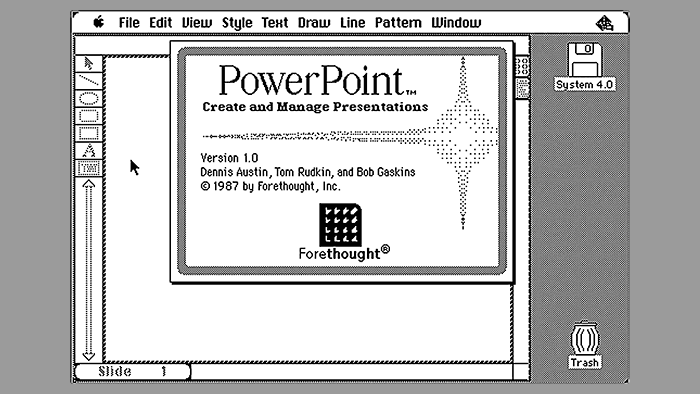
Development officially started under the name "Presenter". However, they started to work on the Macintosh version first. The first developer besides Gaskin was Thomas Rudkin, who joined after 6 months.
January 1987: Funding by Apple
To continue development, the team needed more money. Apple's Strategic Investment Group selected the company for its first investment. One month later, when they announced the software at the Personal Computer Forum in Phoenix, famous Apple CEO John Skully reportedly said "We see desktop presentation as potentially a bigger market for Apple than desktop publishing".
21. January 1987: The name PowerPoint was established
Originally, they chose to keep the name "Presenter" for the final software. However, to everyone's surprise, when they tried to register the trademark, their lawyers replied that the name was already used by another software product. The team had to find a new name quickly and thought about "SlideMaker" and "OverheadMaker". According to Gaskins, one night he came up with "Power point" randomly under the shower. Initially, nobody liked it, but when his colleague Glenn Hobin independently had the same idea (he saw a sign on an airport reading "POWER POINT"), they took it for an omen and stuck with the name. The reason why the name now is a single word with an upper-case P is that back then it was required in the naming of all Macintosh software applications. The common belief that PowerPoint got its name because it "empowers" people is therefore wrong.
20. April 1987: PowerPoint 1.0 (Macintosh)
The first 10.000 copies of the first version of PowerPoint for Macintosh shipped from manufacturing by Forethought Inc. The release was received quite well by the media, commenting it "People will buy a Macintosh just to get access to this product."
July 1987: Acquisition by Microsoft

In early 1987 Microsoft started an internal project to develop a software to "create presentations". Shortly after, they heard that a company called Forethought had nearly finished such a software. The successful release of PowerPoint 1.0 convinced Microsoft to buy the company entirely.
May 1988: PowerPoint 2.0 (Macintosh)
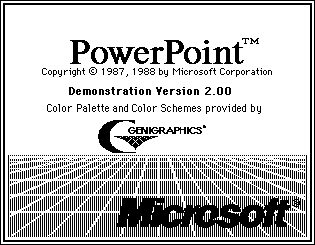
One year later, the second version of the software was introduces. It included color, more word processing features, find and replace, spell checking, color schemes for presentations, guide to color selection, ability to change color scheme retrospectively, shaded coloring for fills.
May 1990: First Windows version of PowerPoint
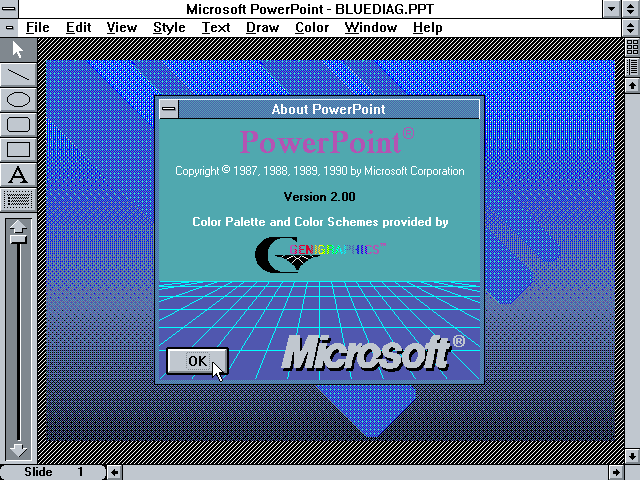
Almost 3 years later, the presentation software was finally released for Windows PCs. It was announced at the same time as Windows 3.0 and was using the same version number as the current Macintosh variant (2.0).
May & September 1990: PowerPoint 3.0
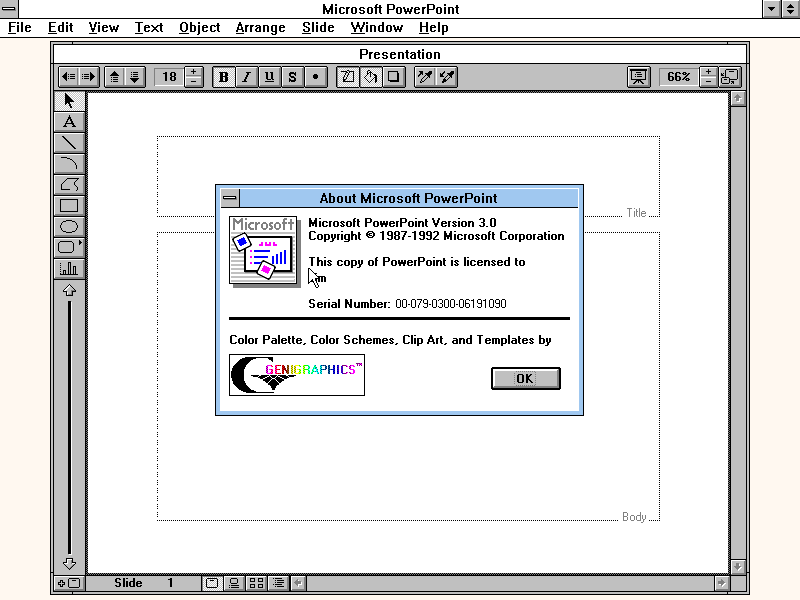
It was the first application designed exclusively for the new Windows 3.1 platform. New features were: full support for TrueType fonts (new in Windows 3.1), presentation templates, editing in outline view, new drawing, including freeform tool, flip, rotate, scale, align, and transforming imported pictures into their drawing primitives to make them editable, transitions between slides in slide show, incorporating sound and video.
February & October 1994: PowerPoint 4.0
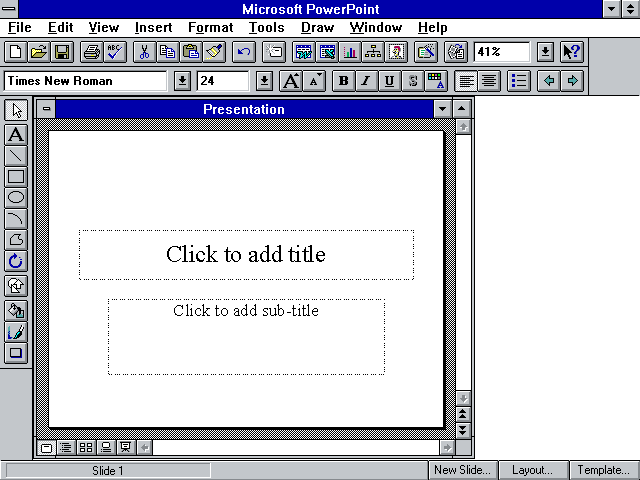
The new version included among others: Word tables, rehearsal mode, hidden slides. Moreover, Microsoft first introduced a standard "Microsoft Office" look and feel (shared with Word and Excel), with status bar, toolbars and tooltips.
July 1995: PowerPoint 95 (new version naming)
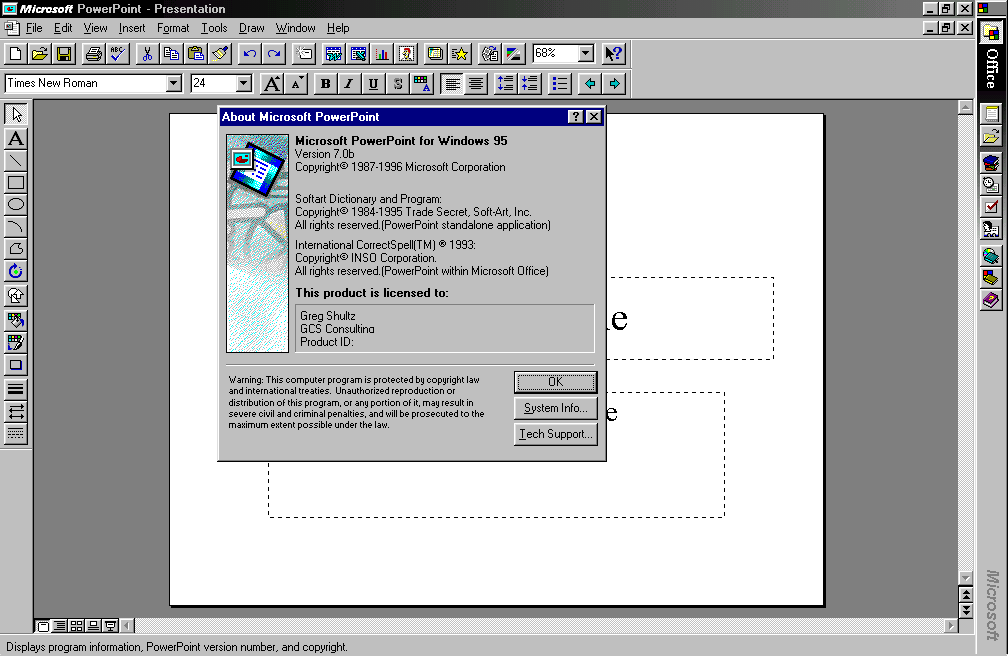
To align PowerPoint with all other Office applications, Microsoft decided to skip versions 5 and 6 and instead call it PowerPoint 95.
October 2003: PowerPoint 2003
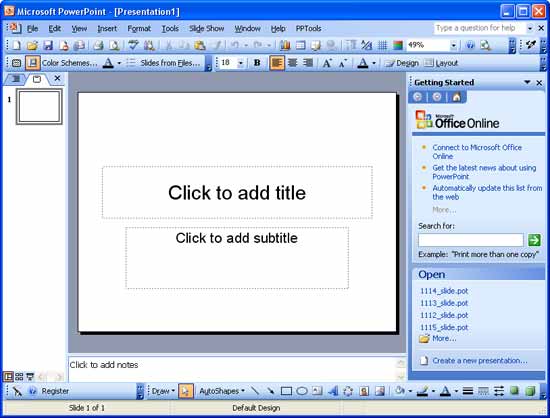
The 2003 version was the first to include the now called "Presenter View": tools visible to presenter during slide show (notes, thumbnails, time clock, re-order and edit slides). Furthermore, it included an option to "Package for CD" to write presentation and viewer app to a CD.
January 2007: PowerPoint 2007
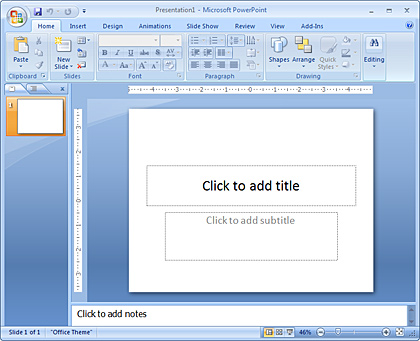
It brought a new user interface (a changeable "ribbon" of tools across the top to replace menus and toolbars), SmartArt graphics, many graphical improvements in text and drawing, improved "Presenter View" and widescreen slide formats. Another major change was the transition from a binary file format, used from 1997 to 2003, to a new XML file format.

June 2010: PowerPoint 2010
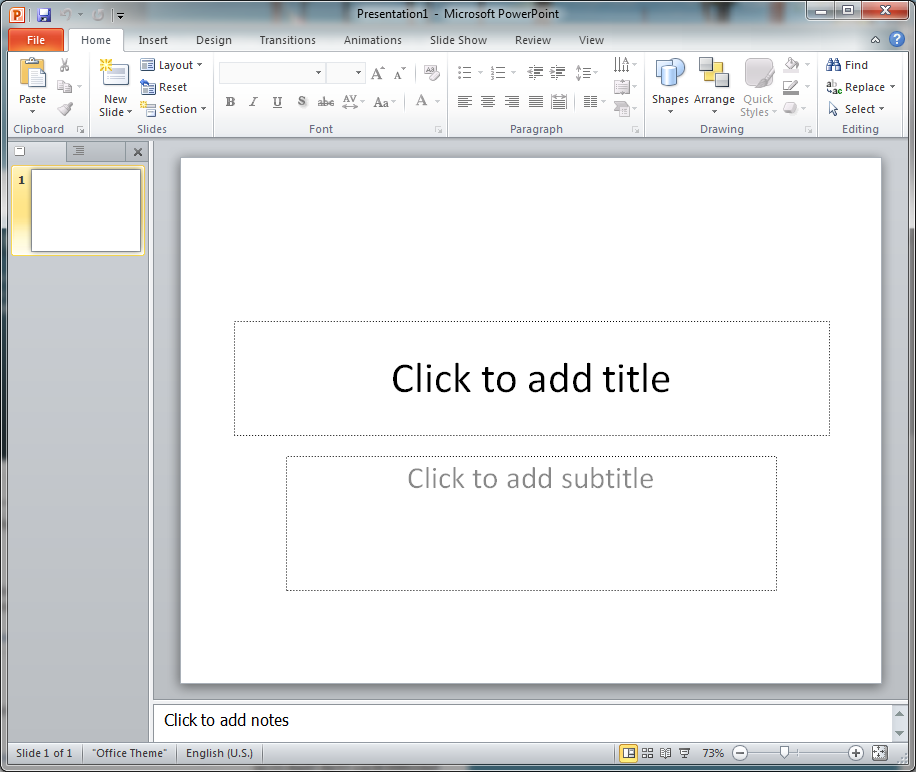
This release added: sections within presentations, a reading view, save as video, insert video from web, embedding video and audio as well as enhanced editing for video and for pictures.
October 2012: PowerPoint for Web was released
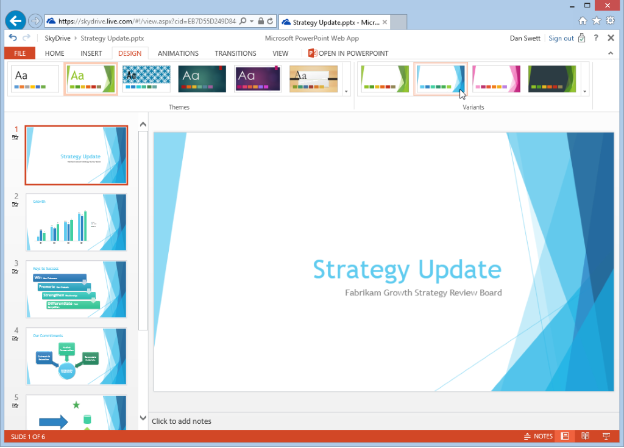
The first time ever, the presentation software could be used in your web browser without any installation.
January 2013: PowerPoint 2013
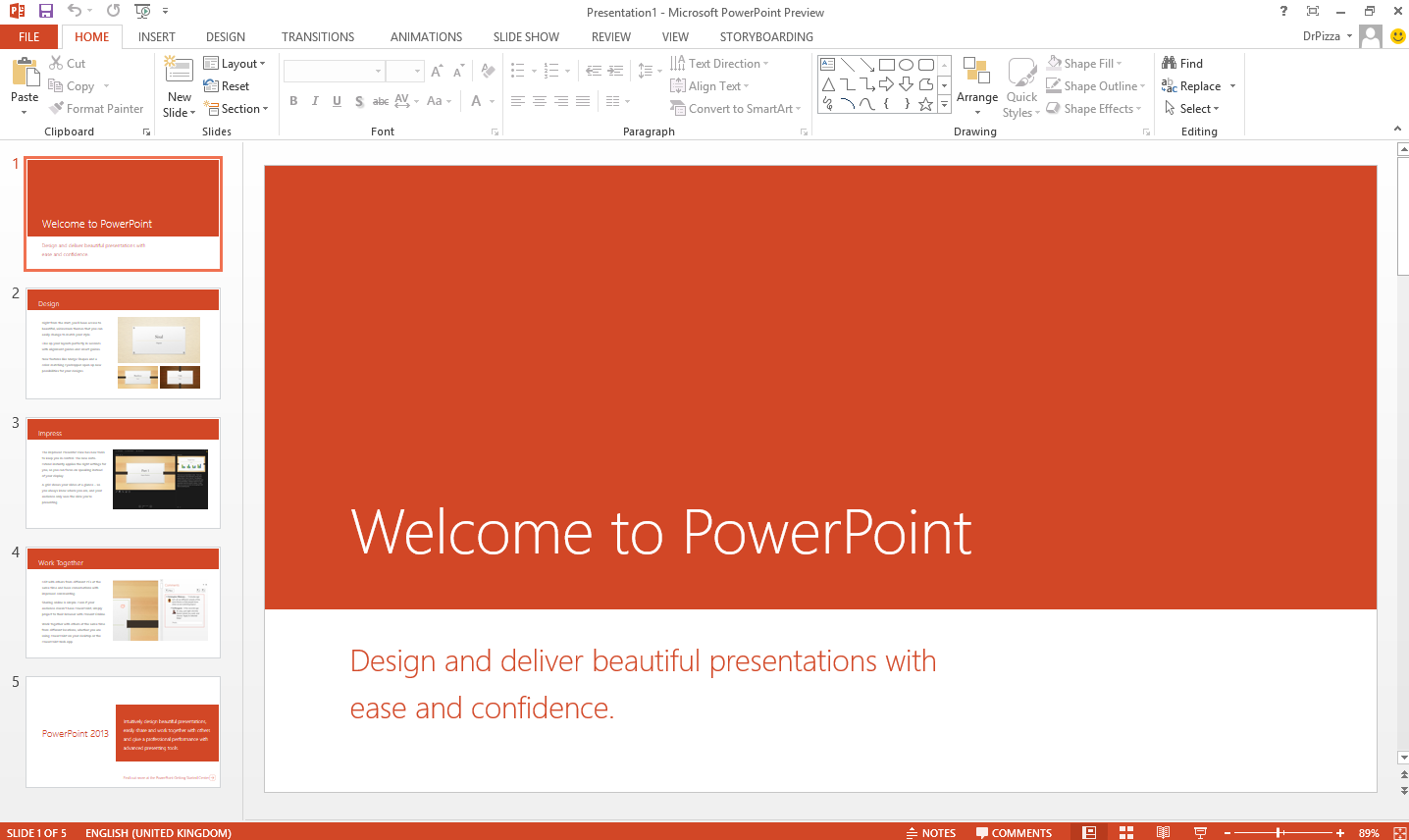
Changes: online collaboration by multiple authors, user interface redesigned for multi-touch screens, improved audio, video, animations, and transitions, further changes to Presenter View. Clipart collections (and insertion tool) were removed, but were available online.
July 2013: First PowerPoint app for Android & iPhone
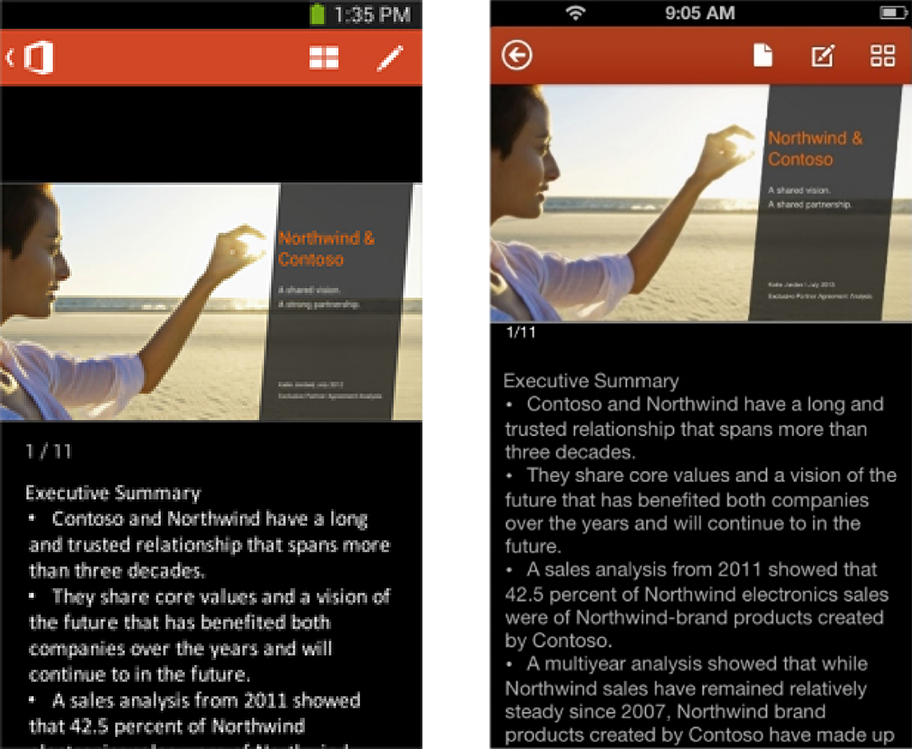
Finally the famous presentation software came on your mobile device with the first versions for Android and iOS. Giving presentations but as well basic editing of slides was already supported on the small screens. However, there wasn’t an iPad optimized version just yet.
September 2015: PowerPoint 2016
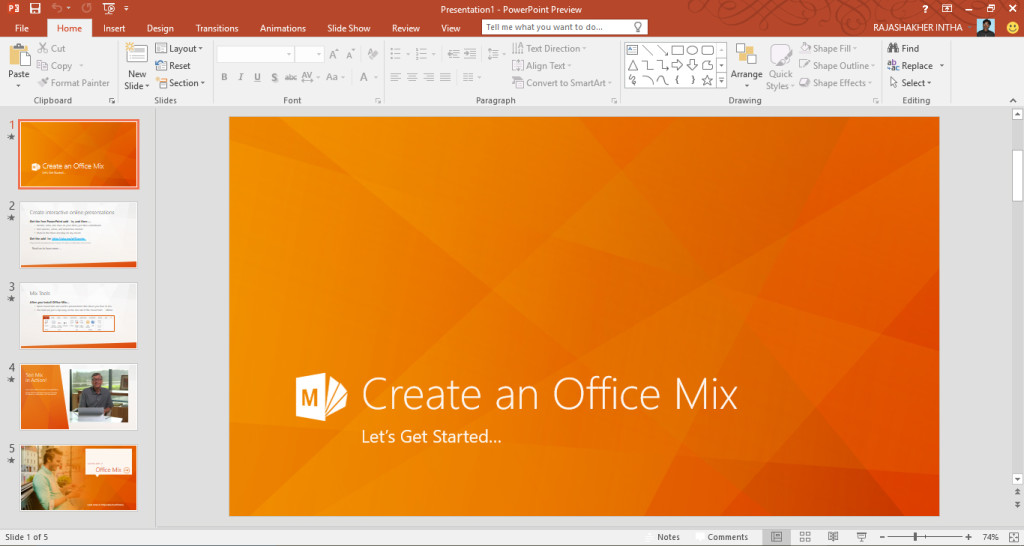
September 2018: PowerPoint 2019
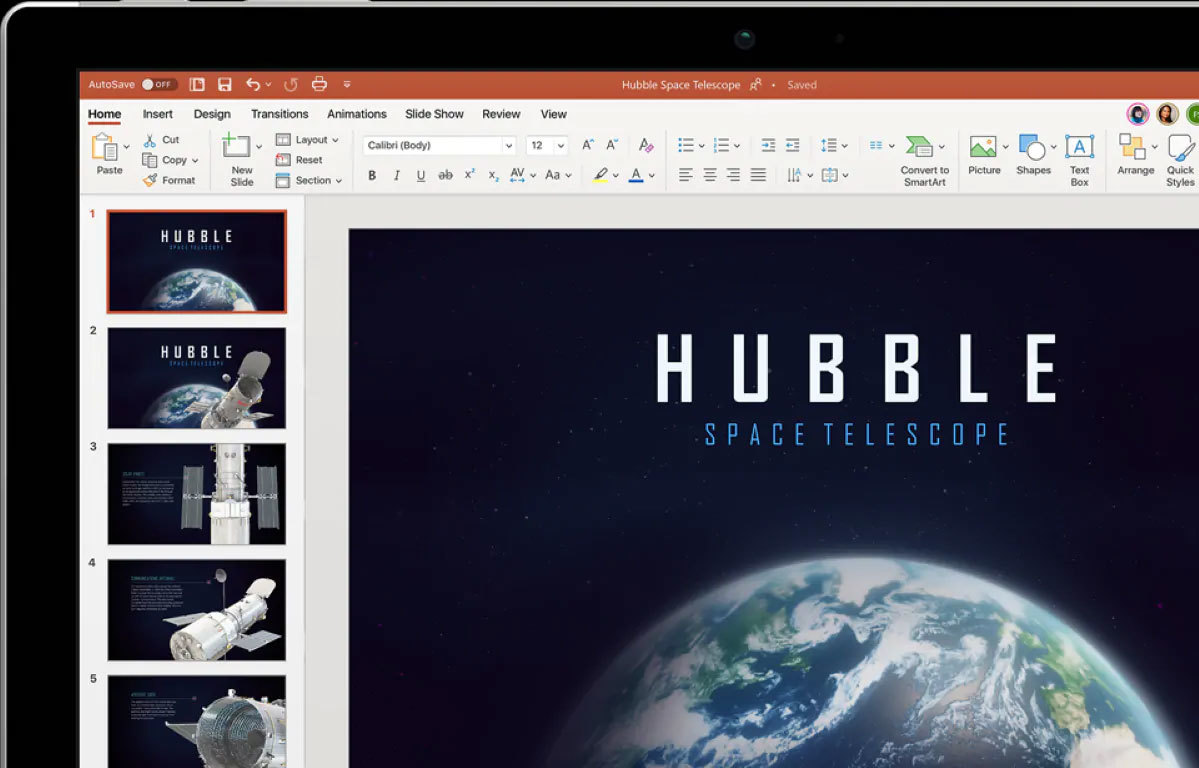
New things in 2019: Morph transition, easily remove image backgrounds, inserting 3D models and SVG icons and a handy Zoom feature.
Are you interested in even more details on the story? You're lucky! Robert Gaskins gave an interview at the 25th anniversary of PowerPoint where he reveals even more on the history of the famous presentation software.
Modern use cases of PowerPoint
Most people use PowerPoint mainly for creating presentations, but did you know that there are many other ways of using the software? PowerPoint is not just for presenting plain slides to your audience - it can do much more - here are some interesting use cases you might not know about:
Games are a great way to lighten the mood during a presentation. Also, they engage the audience. Memory, Charades, or PowerPoint Karaoke - your options are endless! You can choose whatever suits your own presentation style and preference. If you don’t feel like thinking of games yourself, check out the best PowerPoint Games article , where you will get a lot of inspiration, creative game ideas and even a Memory template.
The times of boring, uninspired PowerPoint slides are long gone! Instead, we want to see interactive elements that engage the audience in new, exciting ways! Add Q&A sessions, get your audience’s feedback, share media and capture your audience with stories and unexpected elements! If you want to learn more about audience engagement and interaction, check out our blog post on 10 tools to boost Audience Engagement ! (Also, if you want to save time and energy, you can download SlideLizard , which allows you to create polls, do Q&A sessions, share media and slides and get audience feedback - all in one place!).
Quizzes are extremely popular, and you can create them easily with PowerPoint. We promise that your audience will love them! You can even take your quiz to the next level by matching the design of your quiz to popular quiz shows, like "Who wants to be a Millionaire" (actually, we designed a Who wants to be a Millionaire template with the original design and sound effects so you don’t have to do it yourself). Our advice for quizzes: Use a PowerPoint add-on that allows you to do live quizzes, like SlideLizard . That way you can easily let your audience vote via their smartphones or laptops.
Do you know the struggle of talking in front of a shy audience that doesn’t seem to open up? If you do, you’re definitely not alone: many presenters have to cope with this issue everyday. But there’s good news: By using some icebreaker questions at the beginning of your presentation, you can - well - break the ice. From "How are you feeling today" to "What would your superpower be" you could ask anything, really. Especially funny icebreaker questions (e.g. "Have you ever…?") are known to be very effective. You could even do more than one of these questions in the beginning (to be sure the ice is really broken). We've created a list of 20 great icebreaker questions , which you can use as inspiration.
Common struggles
PowerPoint is easy and intuitive to use - which is the reason why it has become the most used presentation software in the first place. However, there are several little struggles users sometimes have to deal with. They are all easy to solve though, and we will show you how.
Sometimes, the wrong language is set in the beginning, or you would simply like to add another language to your existing one. You can easily change that in the settings. In our blog post, you will get a detailed tutorial on how to install a new language pack and switch to your desired language .
Occasionally, PowerPoint files can get really big in file size. The reason for that are usually pictures or videos within the slides. To save a lot of storage space, you can compress your PowerPoint’s file size (without losing quality!). To learn how to do it, read this detailed step-by-step tutorial on reducing PPT file size .
This problem occurs often: You design a perfect presentation with custom fonts on your computer at home, but once you want to give that presentation on a different computer, all your beautiful custom fonts are gone and replaced with default fonts. That’s really annoying, but can be solved by embedding fonts into your .pptx file .
Templates are so useful, as they save so much time. The sad thing is that not that many people actually use them. We want to contribute to changing that by teaching you how to make your own custom design template for PowerPoint . And if you don’t feel like creating a template yourself, you can download one of ours for free:
- the wonderful Blue Alps template
- the simplistic Elegant Architecture template
- the fresh Caribbean template to get that summer holiday feeling
When was PowerPoint created?
The idea of PowerPoint came up in 1984. In the following years, development started under the name "Presenter". In 1987, the first version of PowerPoint for Macintosh was released. The first Windows release followed in 1990.
When did PowerPoint come out?
The first version of PowerPoint for Macintosh came out on April 20, 1987. The initial Windows version followed 3 years later, in May 1990.
Who created / invented / developed PowerPoint?
Robert Gaskins is one of the inventors of PowerPoint. He developed the first version with the help of his colleagues at Forethought Inc., Dennis Austin and Thomas Rudkin. Microsoft bought the company in 1987.
How old is PowerPoint?
The first version of PowerPoint was released on April 20, 1987, which means that PowerPoint celebrates its 33rd birthday in 2020. However, it was for Macintosh only, the Windows version was release in May 1990.
When did PowerPoint become popular?
According to Google Trends, PowerPoint had its peak in popularity in November 2009 (measured by number of searches). However, PowerPoint was already a popular presentation software in the 1990s.
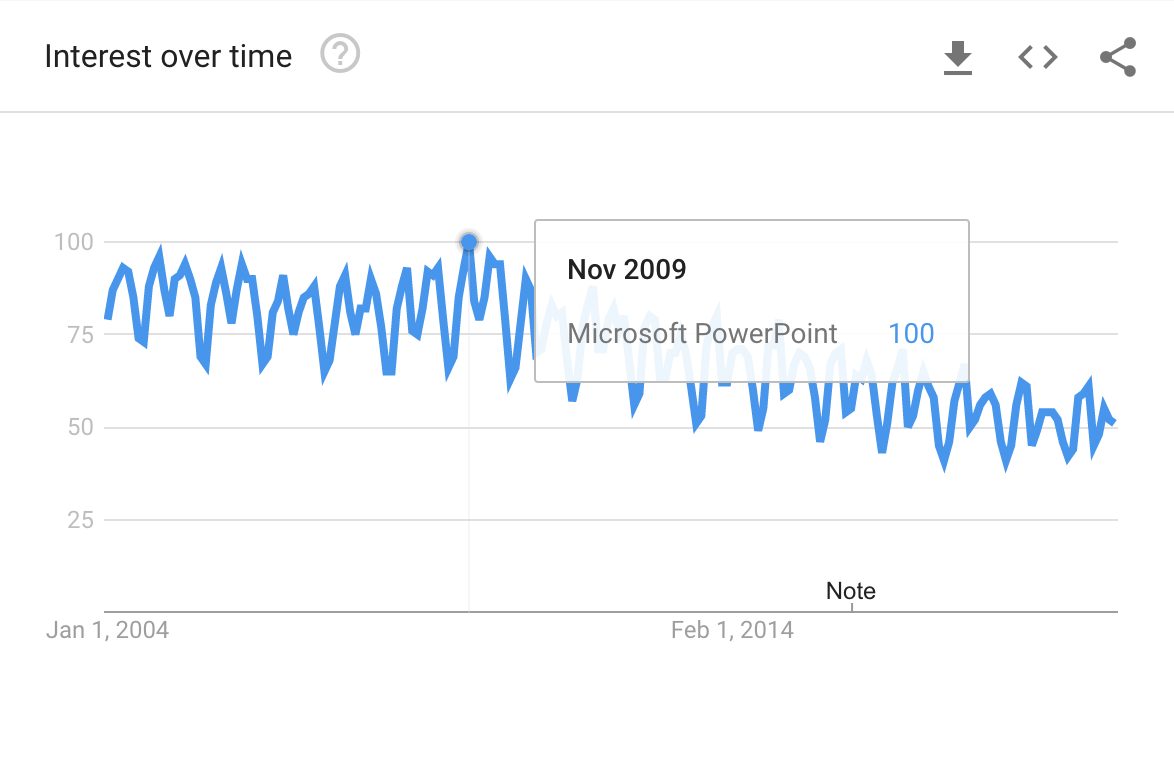
Related articles
About the author.

Pia Lehner-Mittermaier
Pia works in Marketing as a graphic designer and writer at SlideLizard. She uses her vivid imagination and creativity to produce good content.

Get 1 Month for free!
Do you want to make your presentations more interactive.
With SlideLizard you can engage your audience with live polls, questions and feedback . Directly within your PowerPoint Presentation. Learn more

Top blog articles More posts

How to export high resolution images from PowerPoint

How to use the morph transition in PowerPoint

Get started with Live Polls, Q&A and slides
for your PowerPoint Presentations
The big SlideLizard presentation glossary
Title slide.
The title slide is the first slide of a presentation. It usually contains a title and a subtitle.
An e-lecture is a lecture that is held online. Many schools and universities offer e-lectures as technical opportunities improve.
Audience Response System (ARS)
Audience Response Systems (ARS) are technical solutions that are used in presentations in order to increase the interaction between the presenter and the audience. There are various forms of ARS that offer different features.
Hybrid Learning
Hybrid learning means that one group of students are in class at school. Another group of students takes part in class from home at the same time. They both get taught at the same time.
Be the first to know!
The latest SlideLizard news, articles, and resources, sent straight to your inbox.
- or follow us on -
We use cookies to personalize content and analyze traffic to our website. You can choose to accept only cookies that are necessary for the website to function or to also allow tracking cookies. For more information, please see our privacy policy .
Cookie Settings
Necessary cookies are required for the proper functioning of the website. These cookies ensure basic functionalities and security features of the website.
Analytical cookies are used to understand how visitors interact with the website. These cookies help provide information about the number of visitors, etc.

- Download Brochure
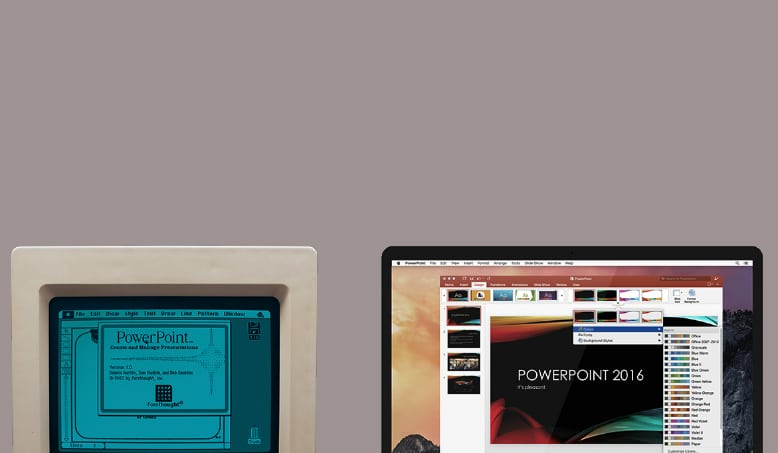
Disruption, innovation, and endurance: A brief history of PowerPoint
The journey of a thousand presentations begins with a single slide.
This is a story about love in the time of ClipArt, about innovation persevering through really lame animations. This is the story of people who refused to copy-and-paste their lives and instead chose to change the world.
“PowerPoint sought to disrupt an established business model, much like Uber is doing to taxis. We offered a superior replacement for a familiar capability.” Robert Gaskins, Inventor of PowerPoint
This is the story of PowerPoint .
Create New Presentation (ctrl+N)
Our opening slide begins in 1984. Robert Gaskins , a computer scientist with a degree from Berkeley, had an idea. He was tired of spending hours preparing projection transparencies and using chalkboards to illustrate presentations.
And so he, with the help of developers Thomas Rudkin and Dennis Austin , set out to create a presentation program that would provide an easy way to make and present slides.
They called this program Presenter , which was later renamed PowerPoint.
Insert New Slide (ctrl+M): The 1980s
The team presented the program and business plan to their software company, fittingly named Forethought , in Sunnyvale, California. And just as Prometheus brought down fire to humans, Forethought quickly spread the revolutionary idea of PowerPoint to the world .
Everyone wanted a bullet point in this story. Apple invested $432,000 in PowerPoint, making it Apple’s first ever venture capital investment . By 1986, the PowerPoint team was using PowerPoint to explain their business strategy. (You can even see their 1986 “New Product Summary” here .)
In 1987, Microsoft managed to outdo Apple for once and snatched up PowerPoint for $14 million .
Insert New Slide (ctrl+M): The 1990s
Following their acquisition , Microsoft released its first official version of PowerPoint in 1990 . By 1993, PowerPoint was making $100 million in sales annually.
The early versions of PowerPoint only produced transparencies , handouts , and speaker notes until the rise of laptops made transparencies obsolete.
1997 became the year that changed the course of PowerPoint history forever. PowerPoint 97 was released with major improvements and updates, most notably, custom animation . This allowed presentations to faded-zoom into the future. And the fact that users needed no special programming skills to animate their presentations made everyone pinwheel into love with PowerPoint.
Save Presentation (ctrl+S): The 2000s to today
Since 1997, PowerPoint has continued to improve and grow. Newer versions have come out with audio and video embedding, web support, and more slide transitions than ever before.
By 2003, PowerPoint revenues for Microsoft were over $1 billion annually . By 2010, Microsoft announced that PowerPoint had been installed on a billion computers worldwide. A study done in 2012 reported PowerPoint held approximately a 95% share of the presentation software market, eclipsing competitors such as Apple Keynote , Google Presentations , and Prezi .
PowerPoint’s continued domination may be down to the program’s gold-standard status in educational settings for students and professors. And, for the most part, people are satisfied with their PowerPoint experience—there is no compelling reason to change. It seems that PowerPoint is here to stay.
Meanwhile, founder Robert Gaskins , has settled into retirement and written a book about inventing PowerPoint for those who want to discover more about the birth of this innovative and enduring program.
Interested in disruptive innovation? To learn more about Hult’s future-focused global business programs, download a brochure .
Like game changers? Break the mould in the business world with a Masters in Disruptive Innovation from Hult. To learn more, take a look at our blog Week of Disruption, Fall 2018: Embracing a changing world, around the globe , or explore overall business challenges with a Masters in International Business instead. Download a brochure or get in touch today to find out how Hult can help you to find out everything about the business world, the future, and yourself.

Priyanka Sen
Related posts, why design thinking is an essential competency for business students in 2024, drip by drip—the first non-profit organization addressing the wastewater problem in the textile industry from hult alum amira jehia, alumni success story: peter windischhofer and kilian kaminski of refurbed, hult and ey us extend ey cpa career path accelerator partnership, hult international business school marks successful 2023 with new academic programs, innovation in higher education award, hult international business school partners with mindflick to boost collaboration and adaptability skills for mbas.

Microsoft 365 Life Hacks > Presentations > Presenting: PowerPoint, a retrospective
Presenting: PowerPoint, a retrospective
The world’s most popular presentation software (with up to 95% market share today) had humble beginnings when it was introduced in 1987. Back then, Rick Astley’s “Never Gonna Give You Up” was topping the charts, people were lining up to see The Princess Bride, and computers were evolving new capabilities in displaying colorful graphics — forever changing the way we interact with our digital assistants, as well as each other.

As Microsoft 365 celebrates ten years of Office apps on the cloud, let’s take a look at the history of PowerPoint , one of the cornerstones of Microsoft’s software suite.
What was the point of PowerPoint?
When PowerPoint came onto the scene, most group presentations in classrooms and conference rooms used overhead projectors. Remember those machines? They relied on transparent sheets that you printed or wrote text directly on, then illuminated by a bulb and aimed at a blank wall. They were bulky, displayed limited visuals, and oftentimes blurry or difficult to focus.

Tell your story with captivating presentations
Powerpoint empowers you to develop well-designed content across all your devices
Instead, PowerPoint was developed to take advantage of new graphics processing capabilities on computers. Its earliest versions could also produce overhead transparencies, but later versions would take advantage of 35mm slides and video projectors, keeping in line with new technological advancements.
A small Silicon Valley startup called Forethought developed PowerPoint 1.0 in 1987. Throughout its three-year development period it was called Presenter, but the name had been taken. One of the key figures at Forethought, Robert Gaskins, thought of “PowerPoint” from a sign he had seen on an airport runway: he imagined the software empowering the user to create and share compelling points in a presentation. The name stuck, and the software sold out upon its first production run.
Microsoft makes PowerPoint a core component of Office
PowerPoint’s popularity caught the attention of Microsoft executives, who visited Forethought shortly after its release. At first, it took them some effort to convince Bill Gates, who wanted to integrate presentation capabilities into Microsoft Word, which had been released four years earlier. But he eventually understood that this wasn’t just a software component, it was an entire genre of capabilities. He signed off on buying Forethought, bringing PowerPoint into the Microsoft fold.
It was a young Microsoft’s first significant software acquisition, for $14 million in 1988 (or $35.5 million today). By taking over Forethought’s headquarters in California, it gave Microsoft a much-needed presence in Silicon Valley.
PowerPoint was core to Microsoft right from the start. When Microsoft Office launched in 1989, what would become the world’s most popular productivity suite included just three programs: Word, Excel, and PowerPoint.
PowerPoint gets folded into Microsoft 365
When Office 365 debuted in 2013, it wasn’t just a software update. These key programs now lived on the cloud, made for mobile life: Sales of laptops were now outpacing desktops; smartphones were smarter and more powerful than ever; and people were doing the Harlem Shake and hitting up Macklemore’s “Thrift Shop.” Now, PowerPoint and others featured dedicated mobile versions for both Android and iPhone. You could create and edit a presentation from anywhere, all while using AI-driven tools to design and animate slides in new ways.
The cultural impact of PowerPoint
As much as PowerPoint has become a staple of business, scientific, and educational presentations, it’s also unlocked new and unexpected avenues of creativity. Here are some of the ways that PowerPoint has expanded into the public consciousness:
- WordArt and animations: You couldn’t miss these stylized texts in the 1990s and 2000s. WordArt added fun special effects like shadows, outlines, and stretches to create eye-catching titles, while PowerPoint’s bouncing, fade-in, and sunburst animations still remain popular.
- PowerPoint parties: Gather your friends and give your silliest presentation on something you love! It’s a twist on the elementary school presentations you might now be nostalgic for—and with drinks, costumes, friends, and fun themes, giving presentations in person or over Microsoft Teams has never been more fun.
- As an artistic medium: PowerPoint’s visual focus and animation capabilities have enabled creatives to express themselves, from users known as “the Prince of PowerPoint” to David Byrne of The Talking Heads. On TikTok, the #powerpoint hashtag has over 4.3 billion views, with user-created tutorials on how you can make your presentations more eye-catching, aesthetically pleasing, and creative.
Over the past four decades, PowerPoint has evolved to keep up with the way we use our laptops and mobile devices—and it’s more powerful, AI-driven, and full of design possibilities than ever.
Get started with Microsoft 365
It’s the Office you know, plus the tools to help you work better together, so you can get more done—anytime, anywhere.
Topics in this article
More articles like this one.

How to create an educational presentation
Use PowerPoint to create dynamic and engaging presentations that foster effective learning.

Five tips for choosing the right PowerPoint template
Choose an appropriate PowerPoint template to elevate your presentation’s storytelling. Consider time length, audience and other presentation elements when selecting a template.

How you can use AI to help you make the perfect presentation handouts
Learn how AI can help you organize and create handouts for your next presentation.

How to use AI to help improve your presentations
Your PowerPoint presentations are about to get a boost when you use AI to improve a PowerPoint presentation.

Everything you need to achieve more in less time
Get powerful productivity and security apps with Microsoft 365

Explore Other Categories
- Presentation creation
- PowerPoint templates
- Presentation training
- Print design
- Pitch deck example
- PPT Template example
- Investor deck example
- Product deck example
- Presentation services
- Infographic design
- Pitch decks
- Investor presentations
- Marketing presentations
- Conference presentations
- Finance presentations
- Product presentations
- CPD presentations
- Training overview
- Virtual presentation skills training
- PowerPoint template training
- Storytelling training
- Our showreel
- Charity presentation example
- Conference presentation example
- CPD presentation example
- Investor deck example – Seed stage
- Investor deck example – Series C
- Marketing presentation example
- PowerPoint template example
- Product presentation example
Blog / PowerPoint Tips / The history of PowerPoint.
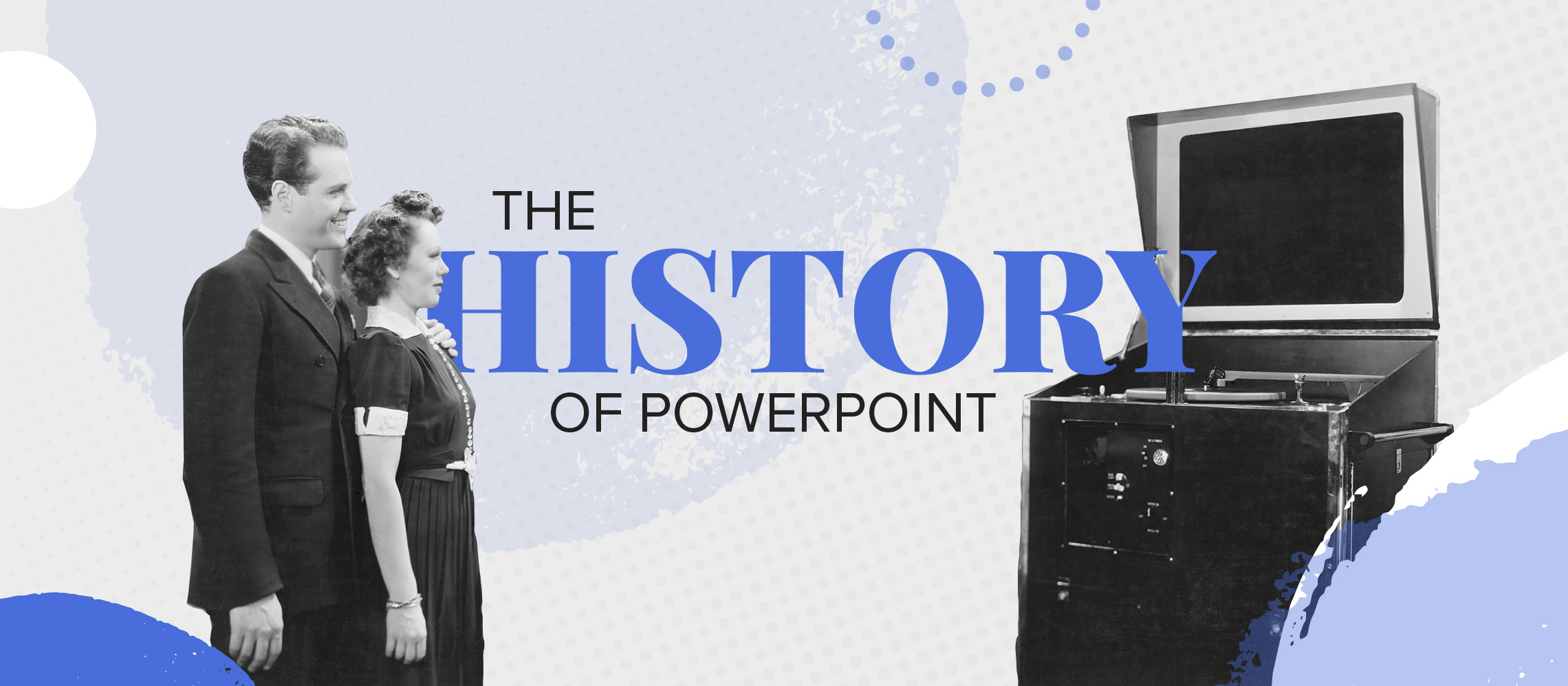
The history of PowerPoint.
The Simpsons made its debut as a series of shorts, Ronald Reagan gave his ‘tear down this wall’ speech, The Bangles were telling us to ‘Walk Like an Egyptian’ and PowerPoint first appeared on the Mac. What year was it? That’s right, 1987. We’d love to get stuck into an 80s pop culture article, but we’ll stick to what we know best. So here’s the history of PowerPoint, from 1987 to present day. But first let’s jump ahead a bit…
It’s 2003. The then U.S. Secretary of State, Colin Powell, walks onto the stage to deliver a speech to the United Nations Security Council. Using PowerPoint as a tool of persuasion, he presents a compelling argument in support of the Bush administration, for the Iraq war. By this point, Bush had already made his decision, but Powell presented a strong case that convinced many that the Iraq war was America’s best option.
Although PowerPoint’s inception was back in 1987, the success and potency of Powell’s speech highlighted just how influential the software had become in the world of public speaking. His 45 slides were uniquely modern, adding a forward-thinking and professional vibe that helped him drive his key points with persuasive flair.
Jump forward 15 years and PowerPoint’s influence on modern life is even more profound then it was back then. 1.2 billion copies of PowerPoint occupy computers all over the world. That’s 1 copy for every 7 people on earth. That’s a lot of copies. Who knows how many slides. But what we do know is that PowerPoint has (rightly so) solidified itself as a staple of modern- day presenting. Those in the business world are witnessing its impact in the present for themselves, but what about its past? Let’s take a look back at the history of PowerPoint: its origins, its growth and how it became a world leader in presentation software .
The origins of PowerPoint
When PowerPoint burst onto the presentation scene back in 1987, it wasn’t the only software available on the market. But it was the best. It’s emergence coincided with a surge in personal computer purchasing and the use of computers in business environments. With business owners hungry for the best presentation software available, PowerPoint came out on top of its predecessors.
But its domination wasn’t immediate. Although widely believed to be Bill Gates’s brainchild, PowerPoint was actually developed by Robert Gaskins, was originally called ‘Presenter’ and released under a company called ‘Forethought’. In a market where consumers had a host of other established programs to choose from, PowerPoint initially struggled to set itself apart from its competitors. The graphics, bulleted lists and slideshows that are so characteristic of PowerPoint nowadays, were not actually PowerPoint’s own, original ideas.
Microsoft sensed PowerPoint’s potential regardless. Seeing the explosion in business software and office automation, Microsoft seized the opportunity and bought the application for $14 million. They developed the software further, taking it to new heights with the release of PowerPoint 97. By eliminating the need for programming knowledge or specialist skills, PowerPoint 97 granted personal computer users access to filmesque features like transitions and animations .
From version 97 onwards, PowerPoint went through major upgrades with every release. A version was released on average every two years, spreading through offices like wildfire. The 2000 version introduced a clipboard feature that could hold multiple objects at once. In 2002, PowerPoint transformed its animation engine, allowing users to take advantage of advanced, custom animations. In 2011, they took the upgrade to another level with new background features and special effects. By 2012, after all the advancements, Microsoft announced their achievement of 95% of the presentation software market share.
The cultural impact of PowerPoint
We can totally see why. From the beginning, PowerPoint has put users first, taking away the complexities, and saving them time and effort. PowerPoint’s prioritisation of ease of use means that even those who aren’t very tech-savvy can still create their own presentations. It has encouraged those who aren’t naturally inclined to do presentations, to at least have a go. It’s made high-quality presenting easier and readily available. Today, users can take advantage of pre-designed templates and animations that give their presentations a slick, professional look.
The software has transformed the world of presenting. It’s used in schools, universities, start-ups, global businesses, people’s homes and governments. After all the years of technological innovation, PowerPoint has stayed at the top of the game. If Presidents and world leaders are using it, it’s probably here to stay.
LIKE WHAT YOU'VE READ? WHY NOT share
Work Can wait
Put off writing that email just a little longer. Send your incoming calls to voicemail. Put your feet up, grab a brew and explore more presentation insight in the Buffalo 7 Library
PowerPoint Version History and Evolution To This Day [2022]
- Share on Facebook
- Share on Twitter
By Nikolay Kaloyanov
in Insights
2 years ago
Viewed 10,099 times
Spread the word about this article:
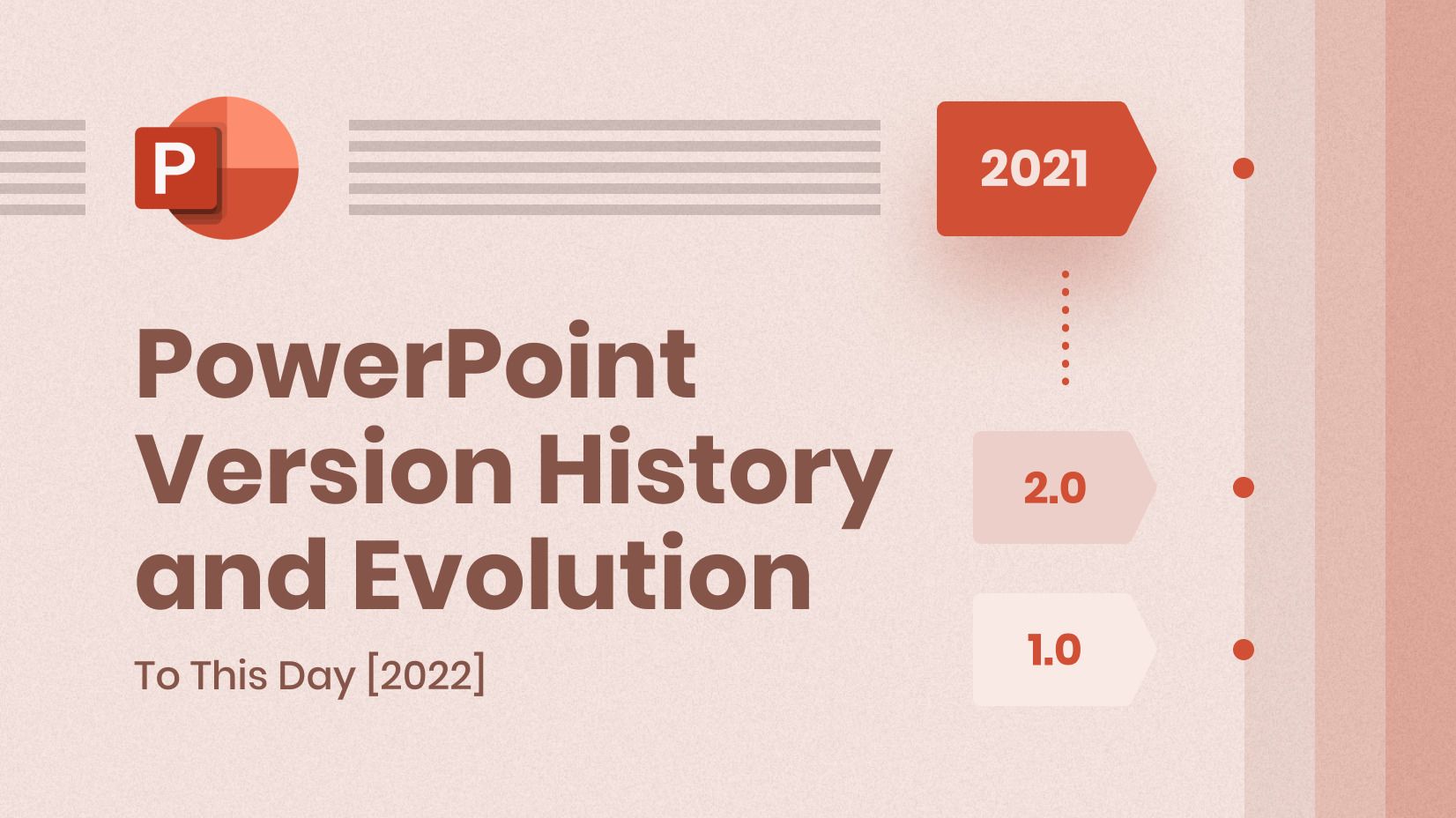
On April 20, 2022, PowerPoint celebrated its 35th birthday. Since then, a lot of things have happened in the software market – we have witnessed the dot com hype, the digital transformation, mobile phone usage increase, and lots of other technological advancements.
But one thing remained – the commanding presence of PowerPoint in the market that nowadays consists of many great presentation software . Has it always been the same? Let’s find out in this article.
Article Overview: 1. Date of Birth 2. Microsoft’s PowerPoint Acquisition 3. PowerPoint version history 3.1. PowerPoint 1.0 3.2. PowerPoint 2.0 3.3. PowerPoint 3.0 3.4. PowerPoint 4.0 3.5. PowerPoint 95 /or PowerPoint 7.0/ 3.6. PowerPoint 8.0/9.0/10.0 3.7. PowerPoint 11.0 3.8. PowerPoint 2007 3.9. PowerPoint 2010 3.10. PowerPoint 2013 3.11. PowerPoint 2016 3.12. PowerPoint 2019 3.13. PowerPoint 2021
1. Date of birth

Robert Gaskins, Co-Founder of PowerPoint. Source: IEEE Spectrum
Every major application has 2 moments that are remembered – the day when it’s launched and the year it goes viral. While the initial idea of the software came up in 1984, the program was launched 3 years later by Robert Gaskins and Dennis Austin.
Robert Gaskins was clear that the multi-billion presentation industry was dated, and it needed a change. That’s why he deeply believed personal computers would change the game. Initially named “Presented”, trademark issues led to the team picking the name “PowerPoint”.
Interestingly, it was made to work on Macintosh, and some of the initial funding came from no one but Microsoft’s arch-rival Apple. The name of the initial company made by Gaskins and Austin was Forethought Inc.
2. Microsoft’s PowerPoint Acquisition
When Microsoft acquired PowerPoint in 1987 for $14 million in cash(or around $35.63M current money), it was considered a bold move. PowerPoint was a unicorn and it was Microsoft’s first big acquisition.
Bill Gates’ company wasn’t a huge player at the time – in fact, it generated just under $200m in revenue in 1986, compared to Apple’s $1.9 billion and IBM’s staggering $51.25 billion.
Putting things into the perspective, Microsoft wasn’t a major player at the time, and PowerPoint 1.0 didn’t help much either. In fact, many were wondering if the huge investment would be worth it.
Well, 3 decades later it’s easy to summarize the influence that Microsoft PowerPoint has had. 89% of people are using PowerPoint, and over 35 million presentations are created a day .
3. PowerPoint version history
PowerPoint has undergone a metamorphosis over the years and that’s obvious. A lot of things have changed and clients have become more demanding. Let’s see how each version looks like.
Pre-Office Era
PowerPoint’s time before it was added to the “elite group” of Microsoft Office tools was very interesting. This is the time when the biggest advancements were made.
3.1. PowerPoint 1.0

Forethought released PowerPoint 1.0 in 1987. It had a black-and-white user interface and 9 menus, and it was available on Macintosh computers. It was a breakthrough, and quite understandably – received amazing feedback back in time.
3.2. PowerPoint 2.0

PowerPoint 2.0 was the first version that was launched after the acquisition. Needless to say, people expected to see changes, and they would do. The most notable change was the introduction of colors – with the second version users could edit color schemes and make more customizations. Also, a lot of other features (such as the “find and replace” tool) were introduced for the first time.
3.3. PowerPoint 3.0
In the history of PowerPoint, there was hardly any bigger update than the transition from 2.0 to 3.0. Most of the features we use today were created for MS PowerPoint 3.0 – including audio, video, and of course – the ability to add presentation templates . This version was the one to come up with slide transitions.
3.4. PowerPoint 4.0

This update didn’t see many big changes but has laid the foundation of what we know as Microsoft Office – a combination of apps that can be utilized by companies (Word, Excel, etc.).
Part of Microsoft Office
PowerPoint history could have been totally different if it was only offered as a standalone product, rather than as a part of something bigger. Fortunately, PowerPoint has been able to share some of the great fonts that were available in Word and import tables from Excel. But it hasn’t always been like that.
3.5. PowerPoint 95 /or PowerPoint 7.0/

PowerPoint 95 took a completely different path. Its code was rewritten in order to be optimized for Windows 95. On top of the improved user experience, presenters could now create more animations and add symbols and clipart. With the Microsoft toolbar, you could easily get access to other Microsoft applications, and for the first time, you could write meeting minutes, thanks to the “Meeting Minder” feature.
3.6. PowerPoint 8.0/9.0/10.0
We’ll combine these 3 versions, as they are the updates before Windows XP took place. We saw PowerPoint advance to a powerhouse. It finally was able to save as HTML files, and during this period the first attempts at collaboration were made (via SharePoint). Also, the first animated GIFs were given life.
3.7. PowerPoint 11.0

PowerPoint 11 is part of Windows Office 2003 and has played its role in the new era in PC software – Windows XP. It gave presenters more freedom regarding their notes, clock time, etc. Other than that, you could use a camera, and enjoy a better overall experience. The legacy 35mm slides were removed.
The end of binary formats
Although still fairly reliable, binary formats were not considered a new technology in 2007. That is why the launch of Microsoft PowerPoint 2007 has put an end to them. The new XML format (.pptx) could make presentations more efficient and interoperable with other pieces of software. Not only that, it would significantly increase the security of the files.
3.8. PowerPoint 2007

PowerPoint 2007 (or PowerPoint 12.0) brought a lot of changes. Apart from the one we mentioned above, there a whole lot of things that took place. Apparently, the UI became more mature and intuitive. Design-wise, new 3D effects, and rotations appeared, as well as SmartArt graphics that allowed you to create all sorts of diagrams. However, what really made PowerPoint 2007 shine is how it became print-friendly – with Print Preview and the support of PDF format. Last but not least – you could finally track presentation changes, and digitally sign documents.
3.9. PowerPoint 2010
PowerPoint 2010 (or PowerPoint 14.0) didn’t bring that many changes but rather improved the layout of 12.0. Still, this PowerPoint version brought a lot of goodies – such as importing videos from the Internet, and different embedding options – including video and audio, plus editing options.
3.10. PowerPoint 2013

PowerPoint 15.0 was rather an addition, than a separate program but it was the first time PowerPoint was available on the web, and collaborations were finally possible. On top of that, the first versions for iOS and Android were released. 2013 was a year to remember for the developers.
3.11. PowerPoint 2016

PowerPoint 2016 was another grand release. It provided an option to collaborate in real-time (something that wasn’t present in 15.0), presentation translations, and brand new Morph transitions that are smoother than standard animations.
3.12. PowerPoint 2019
PowerPoint 2019 doesn’t have the “wow” effect but this is because the previous versions have already delivered most of the great experience. In fact, a few awesome features appeared: vector file imports, inserting 3D models and 360-degree view, export as 4K video, and a great background removal feature.
3.13. PowerPoint 2021
This is the latest version of PowerPoint. While it doesn’t add a lot of things, it finally equals its biggest rival Google Slides in terms of online collaboration . You can now co-author with other people, and write comments to which others can reply.
PowerPoint hasn’t always been the leading presentation software. There was a certain period when Microsoft engineers were wondering if they have wasted their hard-earned money but it wasn’t long after when PowerPoint took off and became one of the most dominant niche programs of all time, and certainly one of the most iconic names in the digital era.
If you find our content valuable, why don’t you check some of our other PowerPoint-related articles:
- How to Insert GIFs into PowerPoint: The Quick Step-by-Step Guide
- How to Convert Your PowerPoint Presentation into Google Slides
- How to Get Started with PowerPoint + Guide and Resources

Add some character to your visuals
Cartoon Characters, Design Bundles, Illustrations, Backgrounds and more...
Like us on Facebook
Subscribe to our newsletter
Be the first to know what’s new in the world of graphic design and illustrations.
- [email protected]
Browse High Quality Vector Graphics
E.g.: businessman, lion, girl…
Related Articles
The best ui/ux design software: complete comparison guide, why & how to use motion capture for education, huion kamvas 22 plus hands-on review, 7 global design magazines you should definitely subscribe to, convert your website design to code – 4 ways to do it, enjoyed this article.
Don’t forget to share!
- Comments (0)
Nikolay Kaloyanov
Nikolay is a copywriter with vast experience in Technology, Marketing, and Design. When he isn't playing with words and crafting texts, he watches sports and asks questions. He is a funny person...until you put him on a diet.

Thousands of vector graphics for your projects.
Hey! You made it all the way to the bottom!
Here are some other articles we think you may like:

Starting an Online Store: A Simple 7 Step Guide to Sell Online
by Lyudmil Enchev
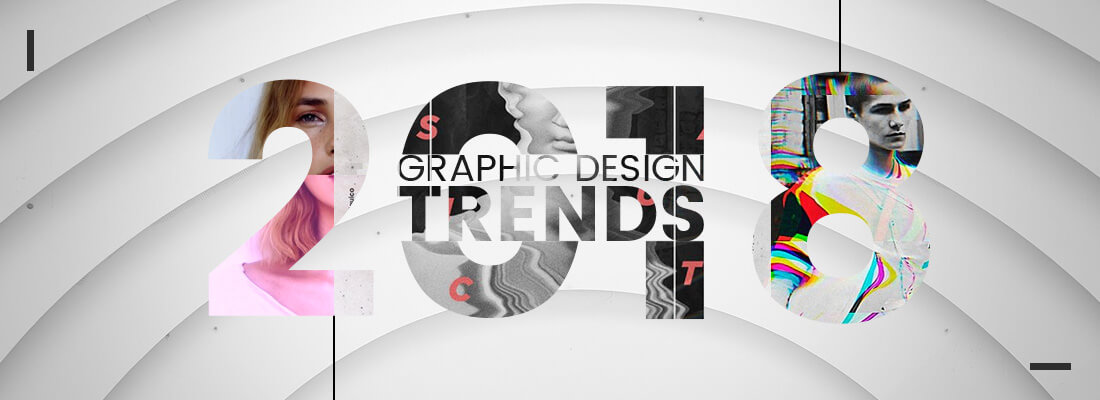
Top Graphic Design Trends 2018: The Ultimate Guide
by Iveta Pavlova

The Best 15 Places to Find Web Design Agencies
Looking for design bundles or cartoon characters.
A source of high-quality vector graphics offering a huge variety of premade character designs, graphic design bundles, Adobe Character Animator puppets, and more.

Looking Back on the Birth of PowerPoint
March 13, 2017 / Blog, Infographics, PowerPoint, Presentation infographics, Powerpoint, powerpoint history
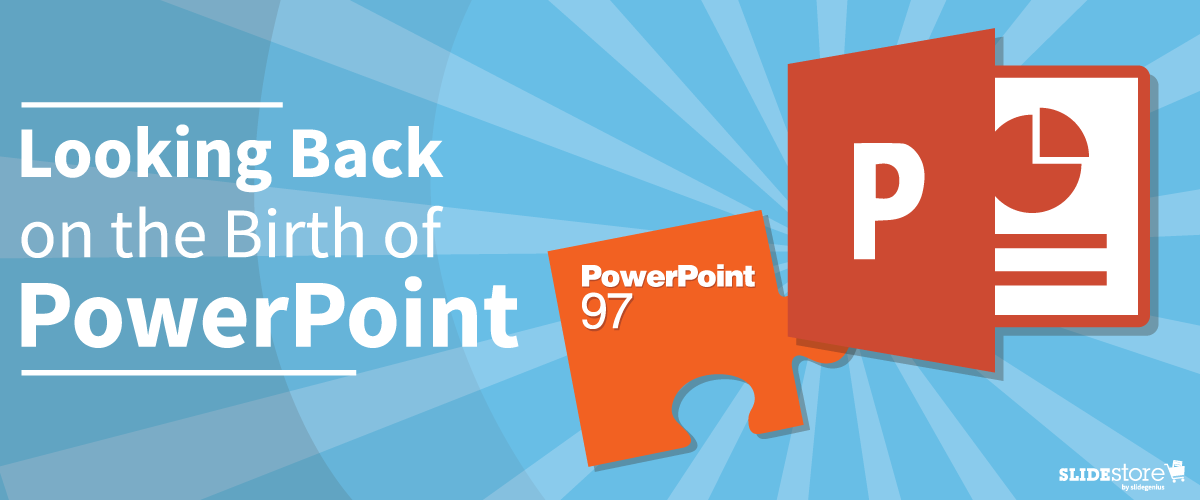
It’s hard to imagine life without the comforts of modern technology that people know today: smartphones, 24/7 Internet access, computers that basically provide anything and everything with the push of a few buttons, and the like. Now, you’d think that innovation is an everyday occurrence, but that wasn’t the case in the mid-1900s, especially for businesses.
Back in the early 60s, Roger Appeldorn invented the first overhead projector . It had a simple principle of using light reflected upon mirrors to display data printed on transparencies (a.k.a. foil or viewgraph), paper-sized sheets of cellophane. The bulky instrument became a mainstay in meeting rooms, but the processes to create one sheet of transparency were tedious and time-consuming (inkjet printing was still a new thing). If not printed, then presenters would handwrite data to be projected on the transparencies. That is, until the 90s. What happened?
Microsoft PowerPoint happened.
Its revolutionary and innovative approach to creating presentations gave it an edge over its more than thirty competitors . Its timing with the booms of both the Apple and Windows operating systems—primitive as they were—cemented its growth. And its fundamental function hosted other uses it wasn’t intended for, like classroom operations and simple public speaking exercises (and not-so-simple ones like the TED Talks ). Yes, it’s that flexible.
Today, PowerPoint is at its latest version: PowerPoint 2016, as part of the Microsoft bundle Office 2016. More than two decades since the first version was published, PowerPoint is at its prime—with no signs of slowing down anytime soon. Although it has seen its share of competitors, the presentation designer software remains as strong as ever, if not stronger.
So how did this juggernaut of a program come to fruition? How about a teaser? For starters, did you know that PowerPoint didn’t start as an internal project of Microsoft? The following infographic will take you through decades across the technological history to the go-to presentation software that is—and will always be—Microsoft PowerPoint.
Akanegbu, Anuli. “Vision of Learning: A History of Classroom Projectors.” EdTech Magazine . February 28, 2013. www.edtechmagazine.com/k12/article/2013/02/vision-learning-history-classroom-projectors
“Life Before the Web – Running a Startup in the 1980’s.” The Zamzar Blog . July 13, 2016. blog.zamzar.com/2016/07/13/life-before-the-web-running-a-startup-in-the-1980s
Popular Posts
Save your deck: methods to recover an unsaved powerpoint file.

Twitter: Lessons from Social Media

Oscar Speech Sounds A Lot Like…..

Olympians Can Teach Presenters a Thing or Two

Overcoming a Public Speaking Disaster: A Lesson from Michael Bay

The Similarities Between Presentations and Advertisments : Super Bowl Edition

Researched by Consultants from Top-Tier Management Companies

Powerpoint Templates
Icon Bundle
Kpi Dashboard
Professional
Business Plans
Swot Analysis
Gantt Chart
Business Proposal
Marketing Plan
Project Management
Business Case
Business Model
Cyber Security
Business PPT
Digital Marketing
Digital Transformation
Human Resources
Product Management
Artificial Intelligence
Company Profile
Acknowledgement PPT
PPT Presentation
Reports Brochures
One Page Pitch
Interview PPT
All Categories
A Brief History of Presentations: How Bill Gates and Microsoft Monopolized All Cave Walls
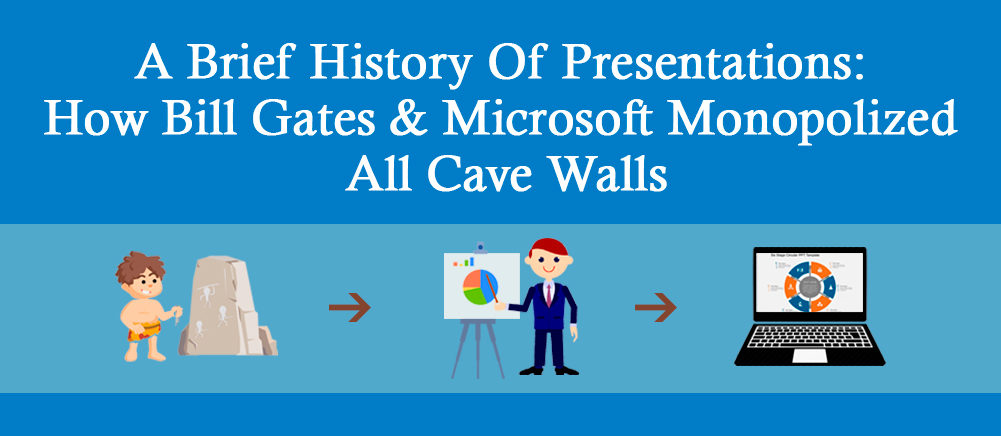
It’s a warm summer evening. The year - 15,000BC. Far away in the caves of Lascaux (France), a primitive homo sapiens has just returned from his daily hunt. His mind in the zone: a creative zone. He lets his hands sway holding whatever colored stone or tool he has, and he paints and etches these murals of horned bulls and other such fauna; murals that will amaze archaeologists into thinking that the basic instinct of visual communication has been with us since time immemorial. Besides, these cave drawings are also a remarkable example of humans’ fascination with presentations.
Before we were clicking and typing away in our computer programs to make a colorful document, there were tools deep-rooted in a chapter of the history of presentations. Modern-day technology has made it possible to create stunning presentations and other visual content in PowerPoint, Google Slides, and Keynote; something that is a far cry from where it all began. In this blog, we trace the timeline of how we came around to making presentations and communicating business ideas and information with their help.
1. Cave paintings
The earliest evidence of human communication and projection of ideas can be traced back to prehistoric times in the form of cave paintings made by the early age humans in Lascaux. These spark the notion that the surface of the cave walls served as a huge slide to the human mind. The prehistoric man described what he may have seen in his surroundings and painted it onto this slide to bring the world’s first-ever presentation to life 20,000 years ago. Sure, he couldn’t write what he had in his mind for us to read, but he could do something even better. He projected what he had seen onto a surface, a concept that forms the basis of any modern-day PowerPoint presentation.
2. Hieroglyphs
Yes, we all went “Ooh” and “aah” when we first came across the drawings of Egyptian gods in the Hollywood classics The Mummy , The Mummy Returns, and The Scorpion King . If archaeological inspection has found anything while digging through the tombs of the revered rulers buried under the Egyptian tombs, it is that with the passage of time, reaching 3000BC, the human intellect had figured out how to use symbols to portray an actual story about those resting in the catacombs. This means that ancient Egyptians actually collected data about the emperors throughout their lives and then presented it to those visiting the tombs. As eyes spanned chamber after chamber, one could find ways to know the deceased through these hieroglyphs (or kill them if they were raised from the dead). Fascinating things lie under those pyramids, don’t they?
3. Bar chart
Transcending ahead to the mid-1300s, there was the advent of bar graphs or bar charts. Reportedly devised and represented in The Latitude of Forms , a bar chart projected a case of uniformly accelerated motion with the help of comparative bars. The classic bar chart quantified the qualities in a more decipherable manner that would give the audience more leverage in understanding the data quickly. With bar graphs, the human mind was able to extrapolate thoughts and data, a concept that modern-day infographics derive from.
4. Chalkboards and whiteboards
This will take all of us back to those old school days. But for some, the chalkboard or blackboard, and its fancy cousin, the whiteboard, emerged from the most rudimentary concepts of learning at school. In ancient times when classrooms had not come into being, students in early settlements used clay slabs as boards to write by etching them with a stylus (which evolved into the current pen or pencil).
In fact, later in the 1600s, teachers were piqued by the wonders a wooden slate and chalk can do for efficient learning. The result of that evolution became a much larger wooden slate hung against a wall and the use of chalk to write on it. Chalkboards thus became synonymous with the most economical way of giving presentations back then. The cheapness of wood and the utility of the duster or eraser made chalkboard a remarkable tool for teacher’s assistance. You could draw your mind to it and just erase it for the next chapter.
Later with the advent of marker ink and whiteboards, it became even more practical to project ideas and lessons without having to worry about coughing on the chalk dust. Thus, communication through whiteboards became a milestone in the history of presentations.
The modern-day presentations have whiteboards and chalkboards to thank for bringing in the need to develop flexible tools to manipulate and edit data in an adaptive manner.
5. Flip charts
Another means of communication whose origins can be traced back to classrooms are the paper flip charts. With printed posters fastened with metal clips, a flip chart enabled a teacher to present detailed information with diagrams. This was an improvement over the chalkboard usage as it eliminated the time lapse involved in copying the printed material onto a bigger surface. Textbooks were aligned according to the lecture content with each poster on the flip chart, which found several teaching applications in the medical courses.
In fact, so versatile were the flip charts that even businesses took notice and started using them to present ideas and pitch entrepreneurial avenues to investors. Slowly and steadily, the flip chart gave birth to poster cards. Businesses used all data and figures and presented them onto sequenced cardboard posters which the presenter went through one by one on a board affixed to a wooden or metallic stand. Soon, the presentations started becoming more refined and data-oriented than before. There was a tool with the presenter, and ideas just flew off the shelf with it.
Instinctively, this laid down the basic groundwork for the slideshows that we see in PowerPoint presentations today.
6. Projectors, filmstrip, and more
While technology and optical advancements kept on growing with the passage of time, it was not until the early 1800s that the first-ever projector was developed. Called by the name “the magic lantern”, it used a flaming candle to project transparencies onto a screen. A transparency was a thin transparent strip of paper or glass through which light can pass and the designs on the strip could be replicated onto a screen.
With the advent of electricity, the projector got modernized. Inventors started figuring out how the very first overhead projector could be used to effectively disseminate information in classroom or business meeting setups. Teachers, in fact, used overhead projectors with transparencies late into the 80s and even early 90s.
However, as the human tryst with knowledge and experimentation kept growing, so did the projector. The average business leveraged this to improve their meeting productivity and corporate communication strategy. With the camera and design technologies climbing new heights, soon the meeting room presentation started employing thin strips of negatives of written and organized information. These filmstrips were able to replicate the contents printed on the reel in the sequential form with each frame capturing each ‘slide’.
Consequently, the slide projector came into action in the 1950s. By this time, corporates had understood how visual content could lead to enhanced learning and information supply. A slide projector used specially designed slides that were prepared much before a meeting and then arranged onto the projector column that used a similar concept as the magic lantern. The only difference was that this time, the light source was powered by electricity. The presenter could present up to 80 slides on a specific topic. To enhance the functionality, however, the presenters also started using pre-recorded voiceovers that were played alongside the presentation for better dissemination of information. An outstanding and revolutionary example of this projector remains the Kodak Carousel Projector, which revolutionized the way lectures were delivered.
Then along came PowerPoint
A significant issue with the slide projectors was the amount of people and resources it went into preparing the slides. Not only that, while transparencies were cheaper than slides, these were not easy to make for an individual and needed a specialized designing resource at work. Moreover, lack of editing capacity and re-usability was also a key issue. A significant drawback was of the portability of the slides and the usual wear and tear and other glitches.
However, it was only due to these drawbacks that need arose for having presentation creating programs, which eventually catapulted the famous PowerPoint on the scene.
Launched in April of 1987, PowerPoint, initially named “Presenter”, was developed by Robert Gaskins and Dennis Austin while working at a Silicon Valley giant, Forethought Inc. The program was launched for Apple Macintosh primarily, and was pitched with its look and feel on the Microsoft Windows 1.0, which was yet to be released back then.
PowerPoint 1.0 was used for producing overhead transparencies in the Macintosh computer. It was only after Microsoft acquired PowerPoint for $14 million in July 1987 that its later versions were used for creating colorful slides that could be used in projectors. It was only after PowerPoint 3.0 was released for both Windows and Macintosh that it began picking up pace.
But before we delve into how PowerPoint became the unconquerable giant it is today , here are some fun facts that add to the run-up to its dominance.
- PowerPoint was Microsoft’s first significant acquisition in its days of competition with early Macintosh computer.
- Did you know that Bill Gates earlier had been for keeping PowerPoint as part of Microsoft Word and not as a separate application? In fact, the earliest versions of Office Suite did not even have PowerPoint as its part. It was only later in the early 1990s that it was sold as part of the Office bundle software.
- Within three years of its launch and acquisition by Microsoft, PowerPoint reported poor sales. It was only after launch of later versions of Windows after 1991 that the sales picked up and PowerPoint grabbed more than half the market share of computer graphic presentation creation software.
How PowerPoint made a difference
At the time of its inception and distribution, PowerPoint had brought together a revolution in the field of presentation in day-to-day official communication. Besides its application with a projector, there were several reasons why the software gathered much traction:
- PowerPoint enabled teachers, businessmen, entrepreneurs and other presenters to create slides at their own discretion and ability instead of waiting for a design vertical to do it for them.
- With each successive version, PowerPoint got more flexibility, intuition, and robustness. Not only could one represent facts and figures, but also could process data with bar graphs, pie charts, funnels, line graphs, and much more.
- Coupled with a portable computer and projector, one could present an entire business pitch deck like this to a group of audience in a meeting.
- It alleviated the pain points that presenters faced regarding portability and distribution. The slides could be printed on paper and even distributed with linked files on a CD-ROM. With the development of data storage technologies, it became even more portable and usable.
- PowerPoint’s linkage with Office Suite apps like Word and Excel added to its popularity. One could just input figures into the excel sheet of each PowerPoint file and then simply choose an infographic to represent that information.
- With each successive version, Microsoft kept improving upon its original concept of “slide master” (or templates as we call them) with additional design variants and more readymade slides to give users a head start in making an eye-catching presentation.
- PowerPoint also enabled users to embed a presentation into a webpage or a blog, or run it as a slideshow, or simply record it as a video.
- The latest version of PowerPoint is capable of churning out stunning animations, audio-visuals, infographics coupled with video insertion as well.
PowerPoint gave the user everything they needed to make eye-catching content. But the term “Death by PowerPoint” also stayed with it persistently. Then again, the point remained that it depended on the presenter to use it precisely and use it better. In fact, a classic example of impressing the audience right off the bat was this pitch deck by dating app Tinder. The focus remained on captivating the audience with an interesting pain point and giving the solution immediately. More needs to be seen on how human instinct for presenting and communicating information enables better and smarter usage of PowerPoint.
What the future holds
Technology is never a bowl of water kept on a table. It is an ever-flowing river of faster and better things. With each wave of genius that methods of presentations have borne, the role of virtual reality and artificial intelligence has become even more prominent. In fact, Microsoft has teased how it plans to use artificial intelligence to make its Office Suite products including PowerPoint more efficient and user-friendly. With time, the tech giant has also forayed into Android and web applications, taking PowerPoint to the user’s fingertips.
While more and more web tools are also coming up (Google Slides, Prezi), the basic concept behind presentations remains efficient communication of ideas. It only remains to be seen how the man who etched murals in Lascaux will keep captivating the minds of his audience with ideas and information in the years to come.
Related posts:
- [Updated 2023] 25 Best Aviation PowerPoint Templates for the Air Transport Industry
- [Updated 2023] Top 25 Brainstorming PowerPoint Templates for Stimulating Out-of-the-box Thinking!
- 25 Best Modern PowerPoint Templates For Winning Presentations
- 25 Best Banking and Finance PowerPoint Templates For Financial Experts
Liked this blog? Please recommend us


Why Every Team Needs a Subscription to Our Collection of PowerPoint Templates... No! Seriously They Do!!

Battling Coronavirus: Dumbledore’s Wise Message Guides Us in These Dark Times

9 Beautiful Presentation Lessons from Kung Fu Panda

PowerPoint Tutorial #1- Cool Way to Create an Envelope for Your PowerPoint Presentation
This form is protected by reCAPTCHA - the Google Privacy Policy and Terms of Service apply.

Digital revolution powerpoint presentation slides

Sales funnel results presentation layouts
3d men joinning circular jigsaw puzzles ppt graphics icons

Business Strategic Planning Template For Organizations Powerpoint Presentation Slides

Future plan powerpoint template slide

Project Management Team Powerpoint Presentation Slides

Brand marketing powerpoint presentation slides

Launching a new service powerpoint presentation with slides go to market

Agenda powerpoint slide show

Four key metrics donut chart with percentage

Engineering and technology ppt inspiration example introduction continuous process improvement

Meet our team representing in circular format


A brief History of PowerPoint (and Facts You Did Not Know)
Last updated on March 25th, 2024
PowerPoint is one of the most widely used applications in the world and yet most people don’t even know about the name of its developer or the fact that PowerPoint was not initially developed for Microsoft Windows but rather for Apple’s Mac OS. It can be fascinating to explore the history of things we take for granted and PowerPoint is no different. Let’s take a look at a history of PowerPoint and some amazing facts you probably didn’t know about Microsoft PowerPoint and when did PowerPoint come out.
Early Development of PowerPoint
PowerPoint was developed by a former Berkeley Ph.D. student known as Robert Gaskins. His idea was to develop an easy-to-use presentation program based on a series of slides. As is the case with most successful ventures, PowerPoint had the most humble beginning from a place one wouldn’t have fancied as the best place to make the most extraordinary presentation software of its time. Gaskins joined a company named ‘Forethought’ and began working on PowerPoint by hiring a developer named Dennis Austin. Forethought was not the ideal place for such a venture because it was a failing Silicon Valley company. It turns out it became the ideal place for Gaskins to develop his software.

The initial release of PowerPoint for Mac and the acquisition by Microsoft
Originally designed for Apple’s Macintosh computers, the first version of PowerPoint was named “Presenter”, however, the name had to be scrapped due to Trademark issues and was later changed to PowerPoint in 1987. The developers of the initial release included Dennis Austin and Thomas Rudkin. The same year Microsoft bought the application for $14 million.

PowerPoint 97 Releases with major upgrades
It can be arguably said that what made PowerPoint as the most widely sought presentation app was its version 97 release. PowerPoint 97 brought new changes to the old version with major upgrades. Earlier versions had linear presentations, whereas, the incorporation of Visual Basic for Applications (VBA) language allowed users to invoke pre-defined transitions and effects within a non-linear style, similar to a movie. The best part was that these transitions and effects required no programming knowledge by the end user.

Evolution of PowerPoint between 1998 to 2010
From version 97 onwards, PowerPoint came up with new features and better templates that improved according to the different UIs and graphics introduced with the passage of time. Before there was the Modern UI, who can forget Windows 98 or Windows 2000 (especially if you are a child of the 90s), which now seems like a UI for a 16-bit game. However, it was not only the UI but other major features that evolved PowerPoint with the passage of time, including the improved Ribbon UI, better formatting tools, web integration, video and audio embedding features and more. PowerPoint releases for Microsoft Windows between 1999-2010 included PowerPoint 2000, 2002, 2003, 2007 and 2010 , whereas, the Mac versions between 1998-2010 included; PowerPoint 1998, 2001, X, 2004, 2008 and 2011.

PowerPoint 2011 for Mac
The latest version of PowerPoint for Mac (till date) is version 2011. PowerPoint 2011 came with increased efficiency and the ability to present presentations remotely, which was a feature geared towards professional users to help them improve communication and reduce travel costs. This feature is known as Broadcast Slide Show and enables the presenter to present presentations via the web without any other software.
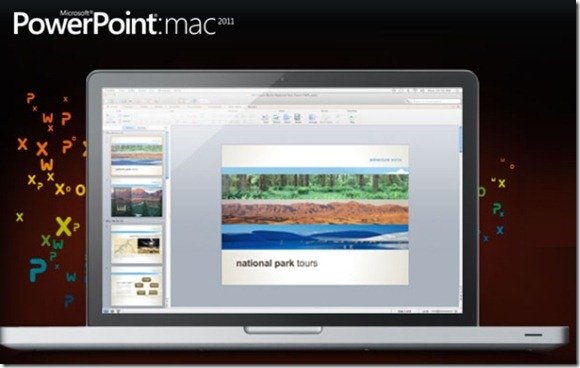
PowerPoint 2013 for Windows
The latest version of PowerPoint for Windows is PowerPoint 2013, which is compatible with Windows 7 and the Modern UI based Windows 8 operating systems. Other than compatibility with the conventional Office Suite, it also comes with the tablet version of Windows 8 called Office RT. You can find out more about PowerPoint 2013 from these posts:
- New features Of Microsoft Office 2013
- Download Microsoft Office 2013 Free Trial

Windows versions of PowerPoint (Timeline)
Below is a timeline of PowerPoint versions for Windows based operating systems, with logos of the most compatible versions of the Windows OS for the given versions of PowerPoint.
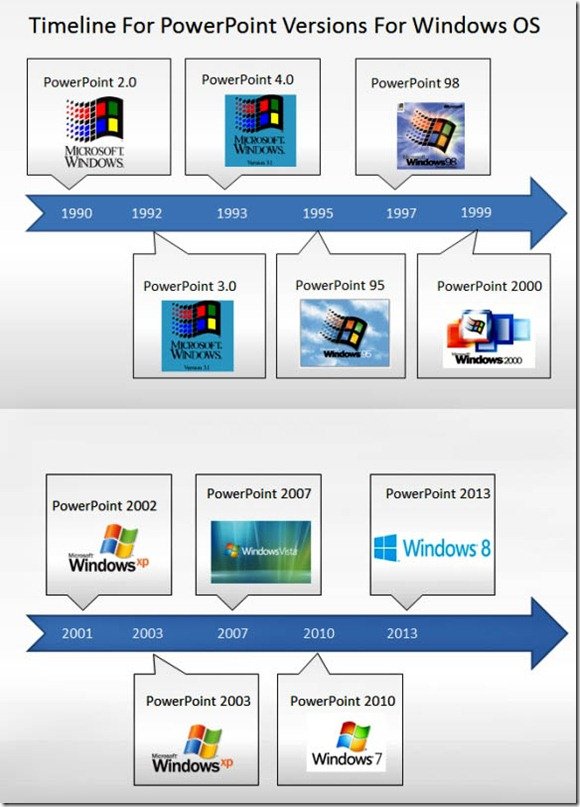
(Timeline Created With: Arrow Timeline Diagram PowerPoint Template )
Mac versions of PowerPoint (Timeline)
Below is a timeline of PowerPoint versions for Mac.

(Timeline Created With: Free Simple Process Timeline Chart Template for PowerPoint )
PowerPoint for Mobile Devices
Recently, Microsoft has released various mobile variants for MS Office applications, including; MS PowerPoint. You can find out more about these apps from the following links:
- Official Microsoft App Released For Android
- Official Microsoft Office App Released For iOS
- Getting Started With Office Mobile For Windows Phone
- How To Install PowerPoint 2013 On Mobile Devices
- Nokia Asha 501: Now With MS Word, Excel And PowerPoint
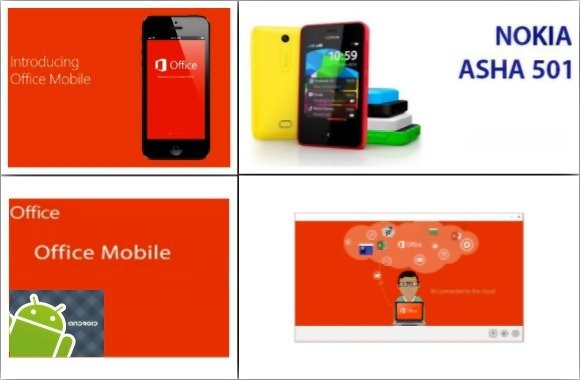
Fan Facts about PowerPoint
Here are some unbelievable facts that about PowerPoint.
Who created PowerPoint?
PowerPoint was originally developed for Macintosh computers by Robert Gaskins and Dennis Austin in 1984. The name of the company that developed PowerPoint was Forethought, Inc., however, at that time the name was not PowerPoint, it was Presenter.
Who owns PowerPoint?
Since the acquisition of PowerPoint back in 1984, the owner of PowerPoint is Microsoft Corporation.
What was the original name of PowerPoint?
The original name for PowerPoint was “Presenter” and it was later changed to just “PowerPoint” to align with the naming convention of other Microsoft Office products.
When was the first version of PowerPoint released?
The first version of PowerPoint for Windows was released in 1987. In this same year, Microsoft purchased the rights to PowerPoint from Forethought, Inc.
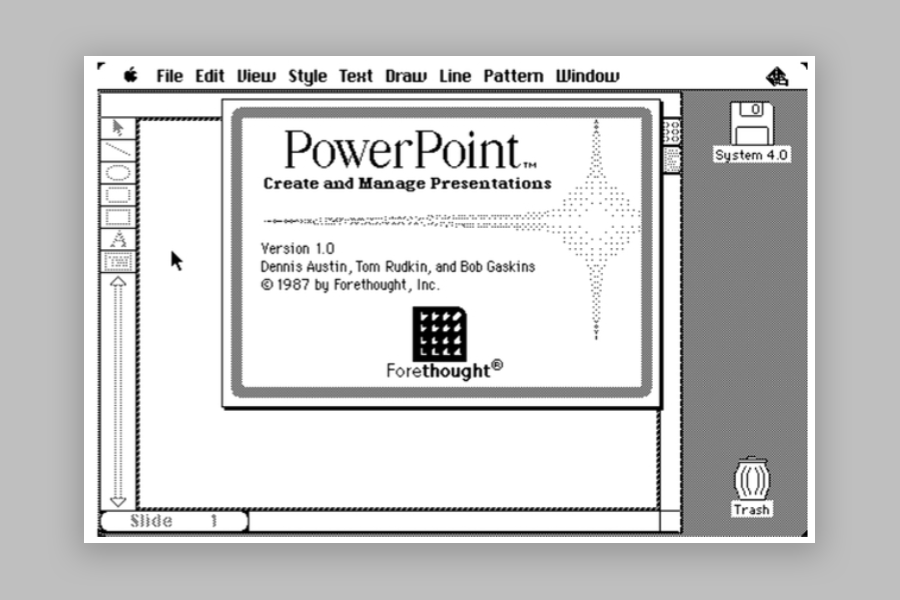
What was the price paid by Microsoft in the acquisition of PowerPoint?
PowerPoint was originally released with the name “Presenter”, and it was available for the Apple Macintosh in 1987. In this same year, Microsoft Corporation ended purchasing the rights to PowerPoint for $14 million from Forethought, Inc.
How many languages are supported in PowerPoint?
PowerPoint is available in over 40 languages.
How many users have PowerPoint?
PowerPoint has over 1 billion users worldwide.
When was PowerPoint created?
Robert Gaskins and Dennis Austin created PowerPoint in 1987. If we consider the first release of PowerPoint as the foundation date, then PowerPoint was first released by Microsoft Corporation on April 20, 1987, and available for the Apple Macintosh computer.
Who created the built-in PowerPoint templates in Microsoft PowerPoint?
PowerPoint’s design templates have been created by professional designers and include over 60 themes and thousands of individual slide designs. Other professional slide templates can be found in sites such as SlideModel.
What was the longest PowerPoint presentation?
The record for the longest PowerPoint presentation is currently held by a group of students from Missouri, who presented for 139 hours straight in 2017.
In 2014, Ryan Allis delivered a presentation titled “Lessons from my 20’s” with 1286 slides ( source ).
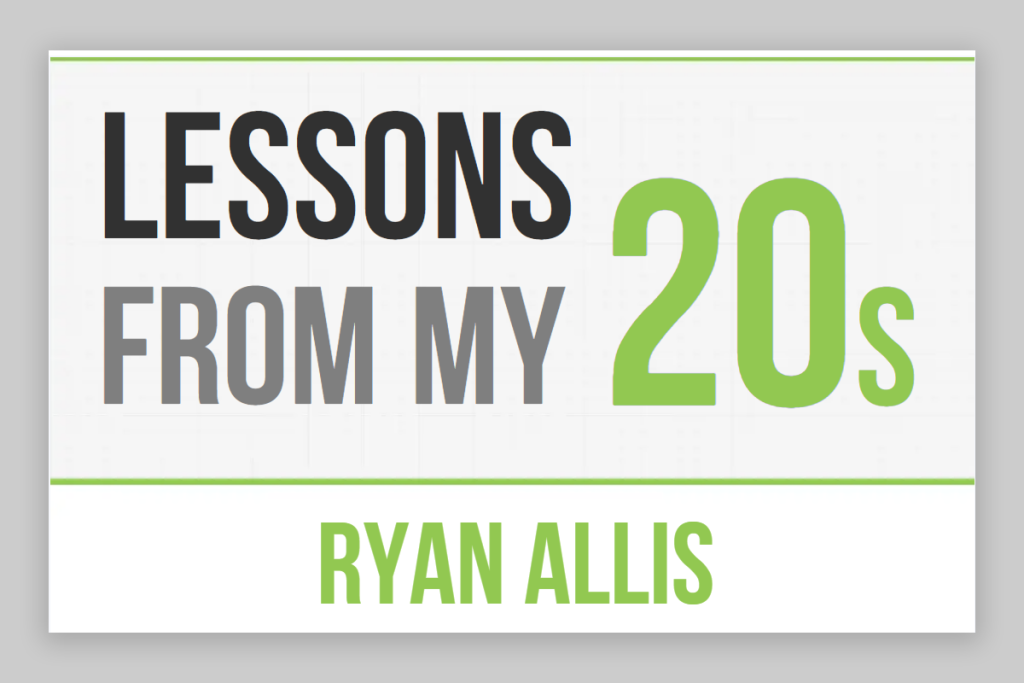
What is the default font in PowerPoint?
The default font in PowerPoint is Calibri, which replaced Times New Roman as the default font in Microsoft Office 2007.
What are some other fan facts about PowerPoint?
PowerPoint has a range of hidden features and shortcuts that can make it easier to use and save time.
PowerPoint has been used for a variety of non-presentation purposes, such as creating animations, designing websites, and even creating art.
The irony of PowerPoint
It’s quite an irony that Robert Gaskins’ PowerPoint attracted the first venture capital investment ever made by Apple, however, after the release of the Macintosh version of PowerPoint in 1987, it became one of the most significant acquisitions ever made by Microsoft. In fact, Microsoft even setup a business unit in Silicon Valley to further develop the application and Robert Gaskins headed the group for five whole years, further enhancing the PowerPoint application. Interestingly, 36 years later, over one billion computers worldwide run PowerPoint.
One comment on “ A brief History of PowerPoint (and Facts You Did Not Know) ”
this is good and learn many things
Leave a Comment Cancel reply
Your email address will not be published. Required fields are marked *
Save my name, email, and website in this browser for the next time I comment.
Sign up to our newsletter
We will send you our curated collections to your email weekly. No spam, promise!

Presentation Guru
A brief history of powerpoint.

According to Microsoft estimates there are more than 500 millions users of PowerPoint worldwide, of which 120 million people are using it to create business presentations and 6 million teachers around the world use it in the classroom. A 2012 study suggested that PowerPoint had 95% of the presentation software market. So for all the talk of death by PowerPoint and how it has alone been responsible for the poor quality of so many presentations around the world, it is fair to say that they must be doing something right. At Presentation Guru we love PowerPoint (and suspect we are not alone in feeling this).
In his article 5 Things You Didn’t Know About PowerPoint , Timo Sorri makes the salient point:
PowerPoint does not make anyone a great presenter, but great presenters do know how to use PowerPoint – or they know how to use experts who can help them with it.
We never cease to be amazed at the endless creativity that the software allows and if you are looking for inspiration, check out these articles which show just what is possible .
Those of us who have been around the block may well remember PowerPoint in its earliest incarnation, and for those of you don’t remember (or weren’t around to) this article from the Hult International Business School is a useful reminder of how far we have come. It’s particularly worthwhile to follow the link to PowerPoint’s very own 1986 promotional presentation ‘New Product Summary’ to get a sense of perspective and realise how high the bar has risen!
You can read the article in full here: Disruption, innovation, and endurance: A brief history of PowerPoint
- Latest Posts

Rosie Hoyland
Latest posts by rosie hoyland ( see all ).
- Now Is the Time to Look at Webinars - 13th March 2020
- The Only PowerPoint Templates You’ll Ever Need - 26th March 2019
- 12 Tips for the Technologically Challenged Speaker - 25th March 2019
- The Best Way to Protect Yourself from Misleading Graphs - 17th January 2019
- 3 Tips to Boost Your Confidence - 13th September 2018

Your email address will not be published. Required fields are marked *
Follow The Guru

Join our Mailing List
Join our mailing list to get monthly updates and your FREE copy of A Guide for Everyday Business Presentations

The Only PowerPoint Templates You’ll Ever Need
Anyone who has a story to tell follows the same three-act story structure to...
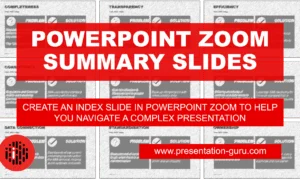
Powerpoint Zoom Summary for interactive presentations – everything you need to know
In this article I’ll be showing you how you can use Powerpoint Zoom to...

How to get over ‘Impostor Syndrome’ when you’re presenting
Everybody with a soul feels like an impostor sometimes. Even really confident and experienced...
- Ad Creative Eye-catching designs that perform
- Social Media Creative Engaging assets for all platforms
- Email Design Templates & designs to grab attention
- Web Design Growth-driving designs for web
- Presentation Design Custom slide decks that stand out
- Packaging & Merch Design Head-turning apparel & merch
- eBook & Digital Report Design Your digital content supercharged
- Print Design Beautiful designs for all things printed
- Illustration Design Visual storytelling for your brand
- Brand Identity Design Expertise & custom design services
- Concept Creation Ideas that will captivate your audience
- Video Production Effortless video production at scale
- AR/3D Design New creative dimensions that perform
- AI-Enhanced Creative Human expertise at AI scale

Related: How to Automatically Save PowerPoint Presentations to OneDrive
Now that you've sorted out the basics, open PowerPoint and load any PowerPoint presentation. There are two ways to check version history here, and we'll show you both.
First, click "File" in the menu bar.
In the left pane, click "Info."
Click "Version History" on the right.
Alternately, you can click the file name at the top of the document that you've opened and select "Version History" from the pop-up menu.
No matter which method you choose, a new pane labeled "Version History" will open up on the right-hand side of your presentation in PowerPoint.
Microsoft PowerPoint sorts older versions of the document by date and time here. To load a previous version of the presentation, click the "Open version" button below the version that you need to go back to.
This will open a read-only file that shows an older version of your PowerPoint presentation. Right below the ribbon menu, you'll see a button labeled "Restore." Click it to go back to the previous version.
Note that this will overwrite your PowerPoint presentation. You can always repeat the same steps to visit the modified version of your document in case you want to copy any additional changes to the older version.
If you use Microsoft 365 apps frequently, you might also be interested in knowing how to restore previous versions of Excel workbooks or Word documents .
Related: How to View and Restore Previous Versions of a Word Document
The World of Teaching
Free Teacher resources including over 1000 Powerpoint presentations
History powerpoint free to download for teachers
Powerpoint presentations on history free to download.
History is the study of past events, particularly human activities, societies, and civilizations. It encompasses the exploration, analysis, interpretation, and understanding of the past based on various sources of evidence, such as written records, archaeological findings, oral traditions, artifacts, and more. History aims to reconstruct and narrate the story of humanity’s journey over time, examining the actions, ideas, and experiences of people from different eras and regions.
Below are a list of historical powerpoint presentations.
By studying history, we can gain insights into how societies have evolved, understand the factors that have shaped human progress, and learn from the successes and failures of the past. It helps us develop a broader perspective and a deeper understanding of our own cultural, social, and political contexts.
Please submit history powerpoints at the foot of this page
Anything you have also produced to enable other history teachers around the world to benefit.
Overall, history provides a foundation for understanding our present, illuminates the complexities of human behavior, and contributes to our collective knowledge and identity as a civilization.
Please submit any of your own powerpoints using the form below. It is very much appreciated.
Your Name (required)
Your Email (required)
Your Message
- Astronomy Presentations
- Biology Powerpoint Presentations
- Chemistry Powerpoint Presentations
- Physics Powerpoint Presentations
- Maths Powerpoint Presentations
- English Powerpoint Presentations
- Geography Presentations
- History Powerpoint Presentations
- Classical Studies Presentations
- Religion Presentations
- French Presentations
- Spanish Presentations
- German Presentations

- SUGGESTED TOPICS
- The Magazine
- Newsletters
- Managing Yourself
- Managing Teams
- Work-life Balance
- The Big Idea
- Data & Visuals
- Reading Lists
- Case Selections
- HBR Learning
- Topic Feeds
- Account Settings
- Email Preferences
How to Make a “Good” Presentation “Great”
- Guy Kawasaki

Remember: Less is more.
A strong presentation is so much more than information pasted onto a series of slides with fancy backgrounds. Whether you’re pitching an idea, reporting market research, or sharing something else, a great presentation can give you a competitive advantage, and be a powerful tool when aiming to persuade, educate, or inspire others. Here are some unique elements that make a presentation stand out.
- Fonts: Sans Serif fonts such as Helvetica or Arial are preferred for their clean lines, which make them easy to digest at various sizes and distances. Limit the number of font styles to two: one for headings and another for body text, to avoid visual confusion or distractions.
- Colors: Colors can evoke emotions and highlight critical points, but their overuse can lead to a cluttered and confusing presentation. A limited palette of two to three main colors, complemented by a simple background, can help you draw attention to key elements without overwhelming the audience.
- Pictures: Pictures can communicate complex ideas quickly and memorably but choosing the right images is key. Images or pictures should be big (perhaps 20-25% of the page), bold, and have a clear purpose that complements the slide’s text.
- Layout: Don’t overcrowd your slides with too much information. When in doubt, adhere to the principle of simplicity, and aim for a clean and uncluttered layout with plenty of white space around text and images. Think phrases and bullets, not sentences.
As an intern or early career professional, chances are that you’ll be tasked with making or giving a presentation in the near future. Whether you’re pitching an idea, reporting market research, or sharing something else, a great presentation can give you a competitive advantage, and be a powerful tool when aiming to persuade, educate, or inspire others.
- Guy Kawasaki is the chief evangelist at Canva and was the former chief evangelist at Apple. Guy is the author of 16 books including Think Remarkable : 9 Paths to Transform Your Life and Make a Difference.
Partner Center
Got any suggestions?
We want to hear from you! Send us a message and help improve Slidesgo
Top searches
Trending searches

12 templates

68 templates

el salvador
32 templates

41 templates

48 templates

33 templates
History Presentation templates
Free history google slides themes and powerpoint templates for your presentations. download them and make your cultural projects stand out with the large amount of graphic resources included., related collections.
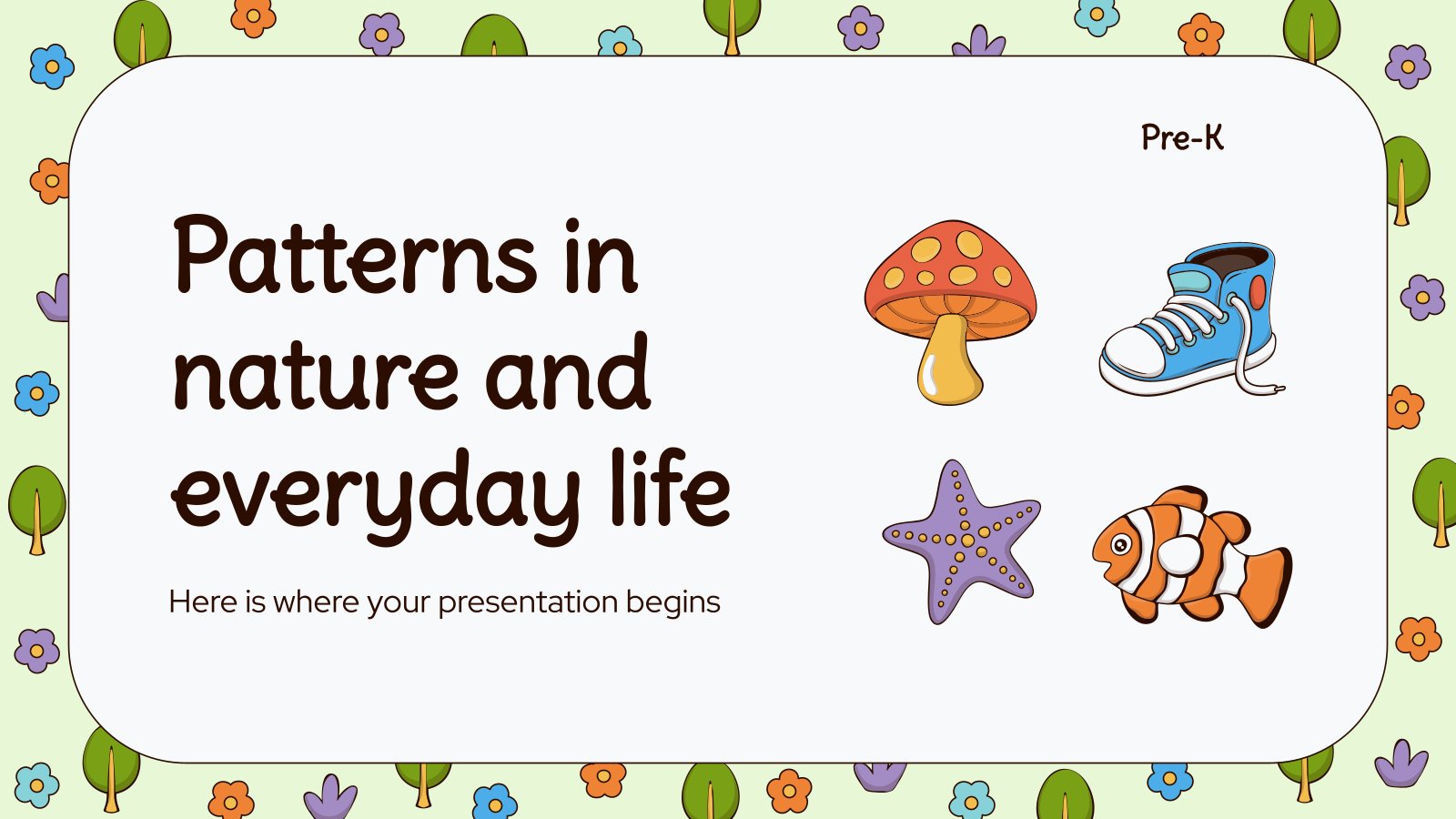
13 templates

65 templates

Middle School
133 templates
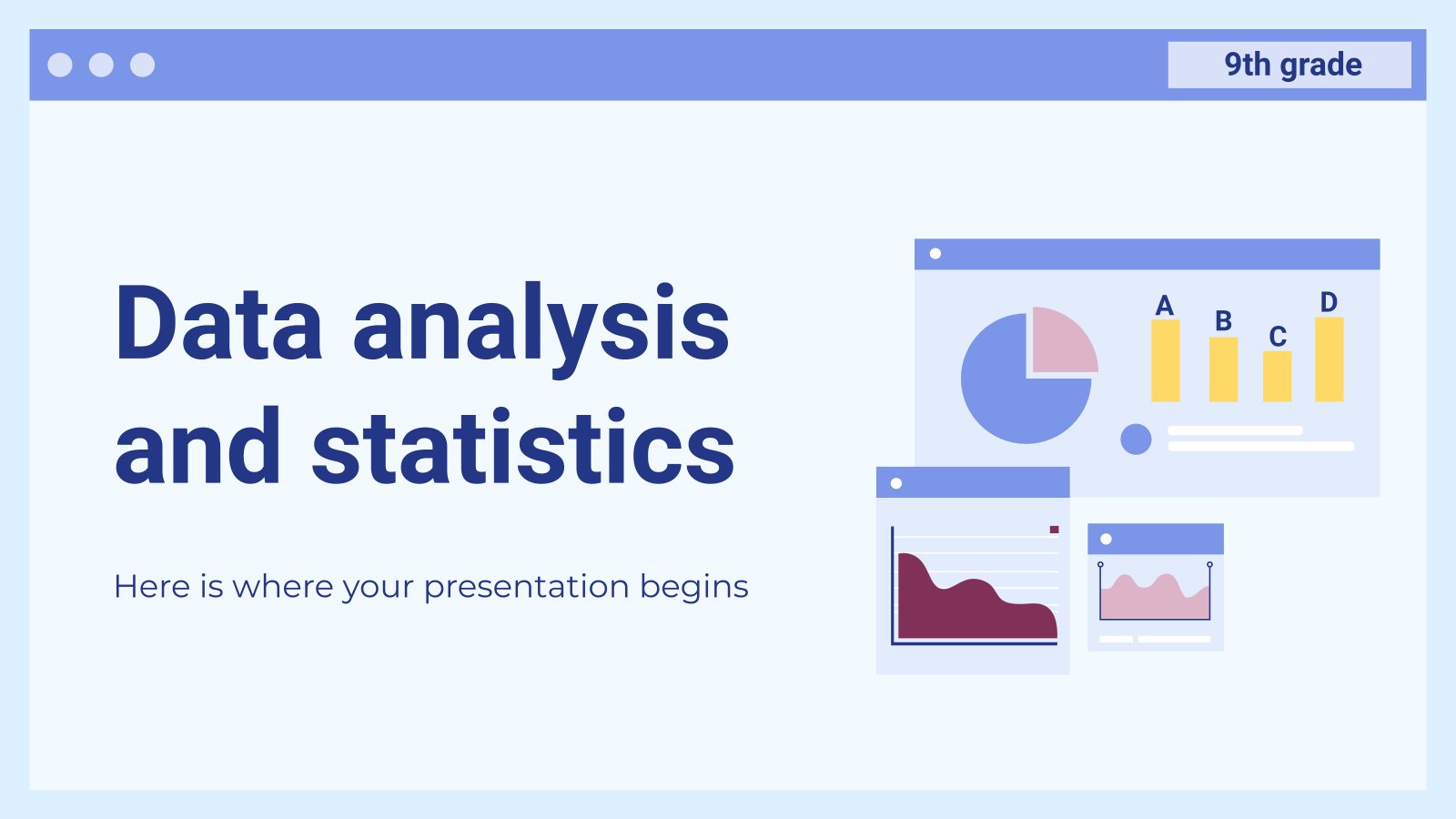
High School
223 templates

81 templates
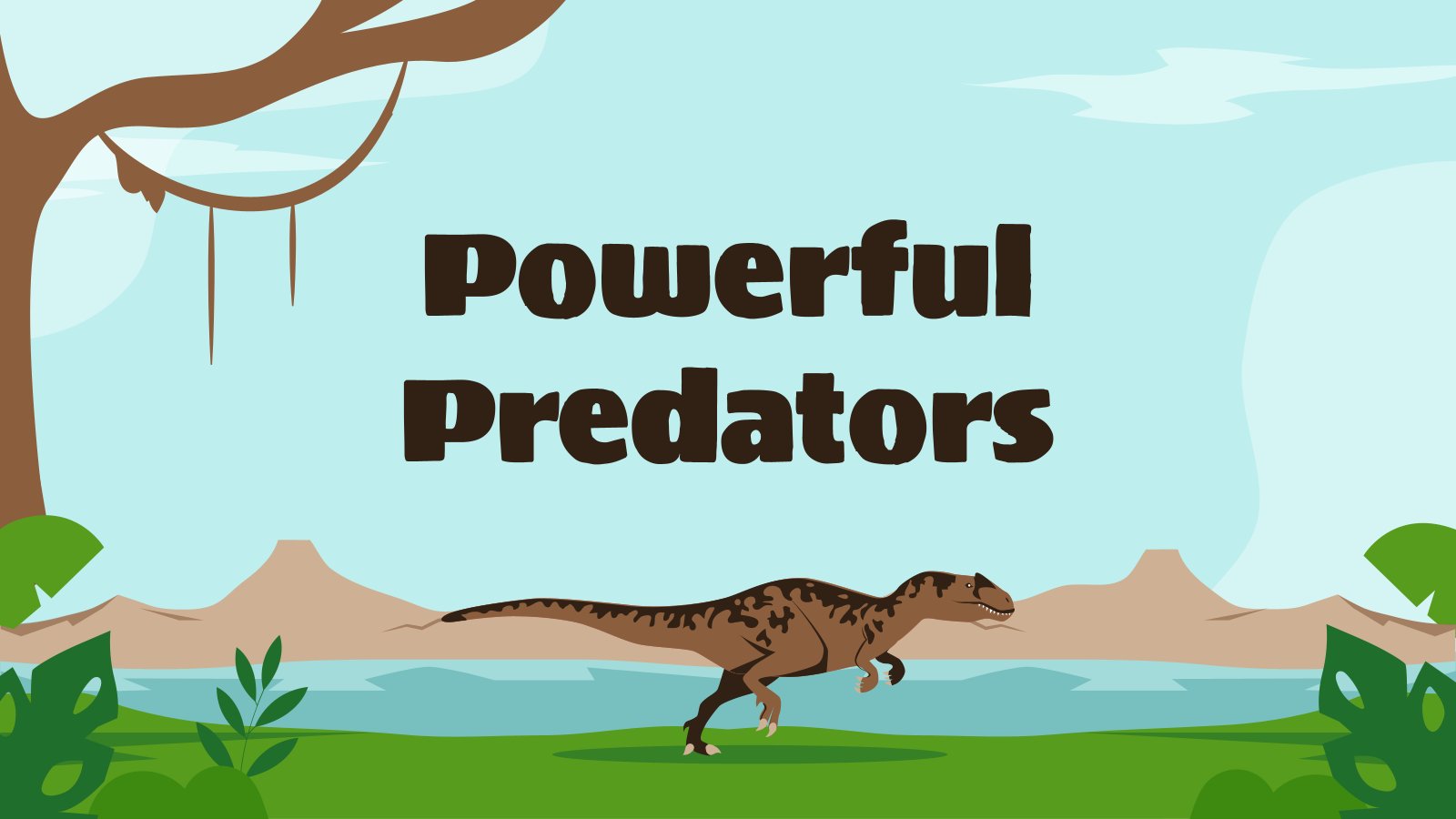
Premium template
Unlock this template and gain unlimited access
Powerful Predators
Download the Powerful Predators presentation for PowerPoint or Google Slides and teach with confidence. Sometimes, teachers need a little bit of help, and there's nothing wrong with that. We're glad to lend you a hand! Since Slidesgo is committed to making education better for everyone, we've joined hands with educators....

Social Studies & History Subject for Middle School - 6th Grade: Ancient World History
Learning about our past is the best way of understanding our present. This template is perfect to present your students the different civilizations that emerged in ancient history and make them passionate about history. The slides have an appealing antique look that will take your audience in a trip to...

The Haitian Revolution: Slave Rebellion
Download the The Haitian Revolution: Slave Rebellion presentation for PowerPoint or Google Slides. The education sector constantly demands dynamic and effective ways to present information. This template is created with that very purpose in mind. Offering the best resources, it allows educators or students to efficiently manage their presentations and...
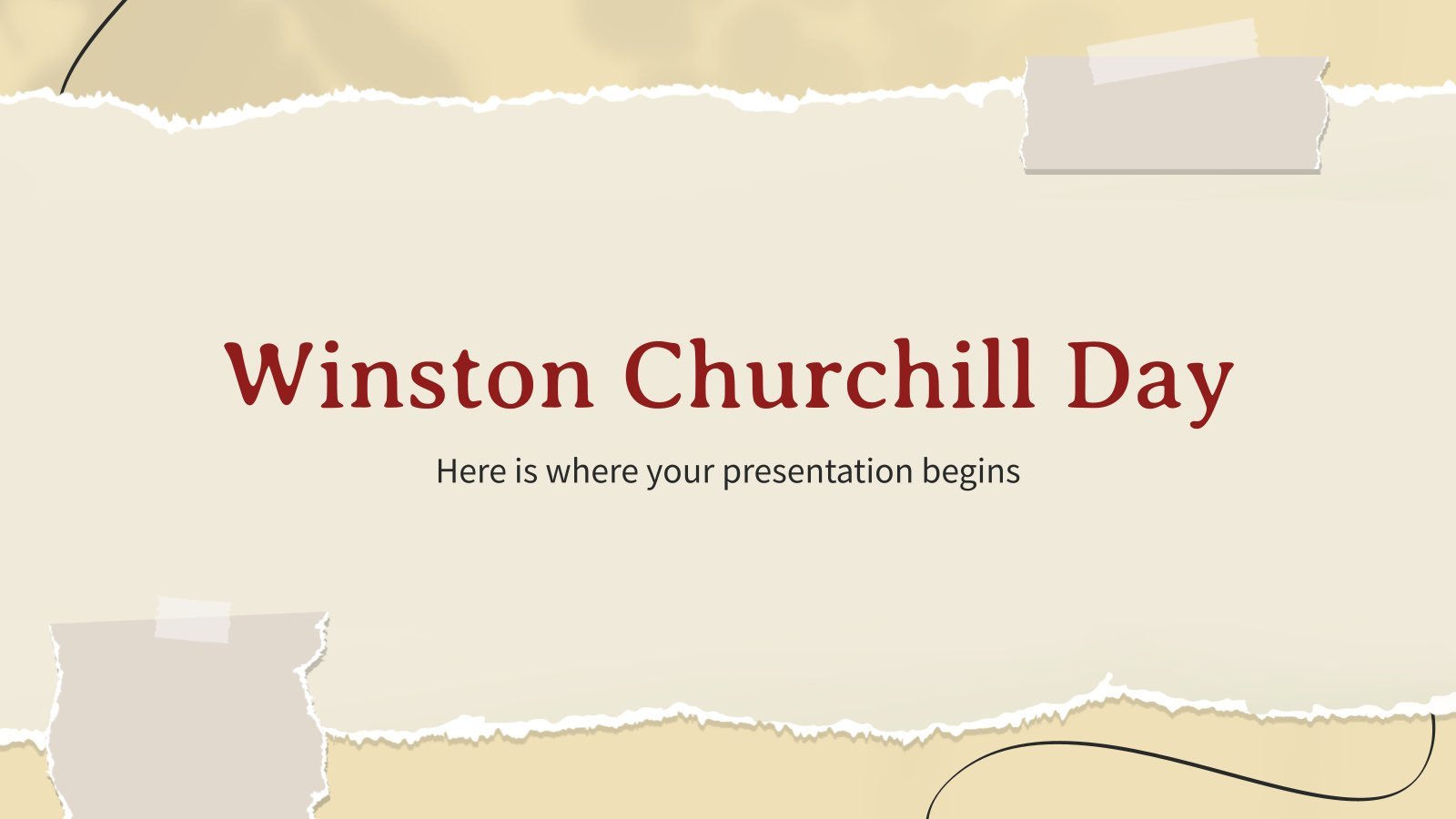
Winston Churchill Day
Download the Winston Churchill Day presentation for PowerPoint or Google Slides. The education sector constantly demands dynamic and effective ways to present information. This template is created with that very purpose in mind. Offering the best resources, it allows educators or students to efficiently manage their presentations and engage audiences....

Papyrus History Lesson
History lessons tend to be boring for students, since they need to remember dates and a bunch of information. Make it entertaining by editing our free presentation template, whose backgrounds based on ancient papyrus rolls take it to the next level.
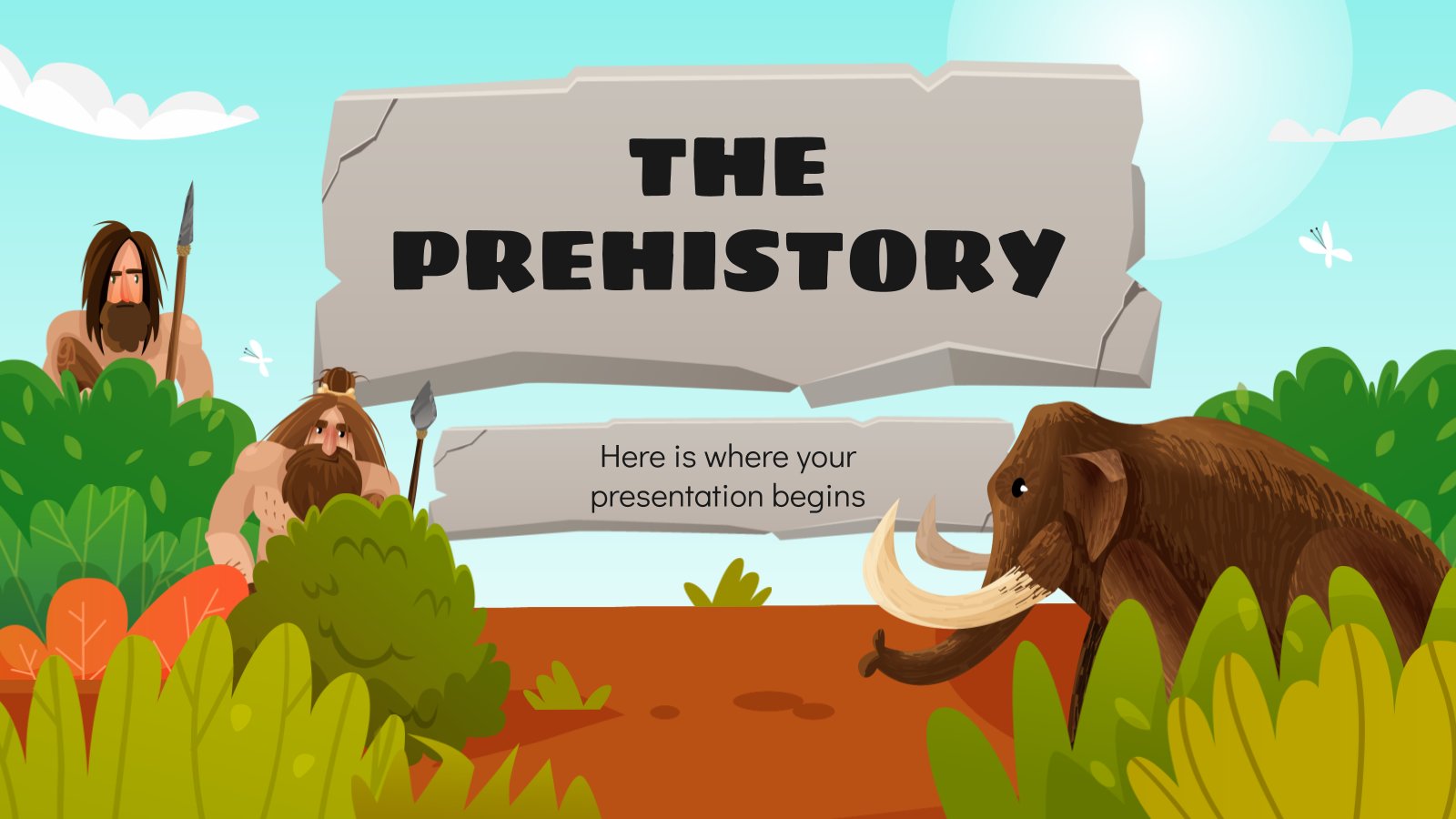
The Prehistory
It is agreed that prehistory is the period of time previous to the invention of writing systems. We all think of people as cavemen, with giant clubs and wearing some kind of clothing made of fur. Prehistory is more than that! Teach all you know, and all your students need...

Vintage Paper History Lesson
Take your students on a fascinating journey through global history! Speak about human evolution, cultural and religious history, important inventions and political developments with this lovely presentation template with a background of creamy, vintage paper scraps. You can edit the graphs, map and everything else in these slides easily, so...

Cinco de Mayo
Download the Cinco de Mayo presentation for PowerPoint or Google Slides and start impressing your audience with a creative and original design. Slidesgo templates like this one here offer the possibility to convey a concept, idea or topic in a clear, concise and visual way, by using different graphic resources....

Art Subject for Elementary - 2nd Grade: Art History
Already at elementary level, you can make your students connect with the beauty and the aesthetic objects. How? By teaching Art History. Have this template as an extra resource for your class and use slides to reinforce the contents of the lesson. The layouts are not complicated at all: there...

History Subject for High School in Spain: Constitution Day Infographics
Download the History Subject for High School in Spain: Constitution Day Infographics template for PowerPoint or Google Slides and discover the power of infographics. An infographic resource gives you the ability to showcase your content in a more visual way, which will make it easier for your audience to understand...

Start of Ramadan
Download the Start of Ramadan presentation for PowerPoint or Google Slides and start impressing your audience with a creative and original design. Slidesgo templates like this one here offer the possibility to convey a concept, idea or topic in a clear, concise and visual way, by using different graphic resources....
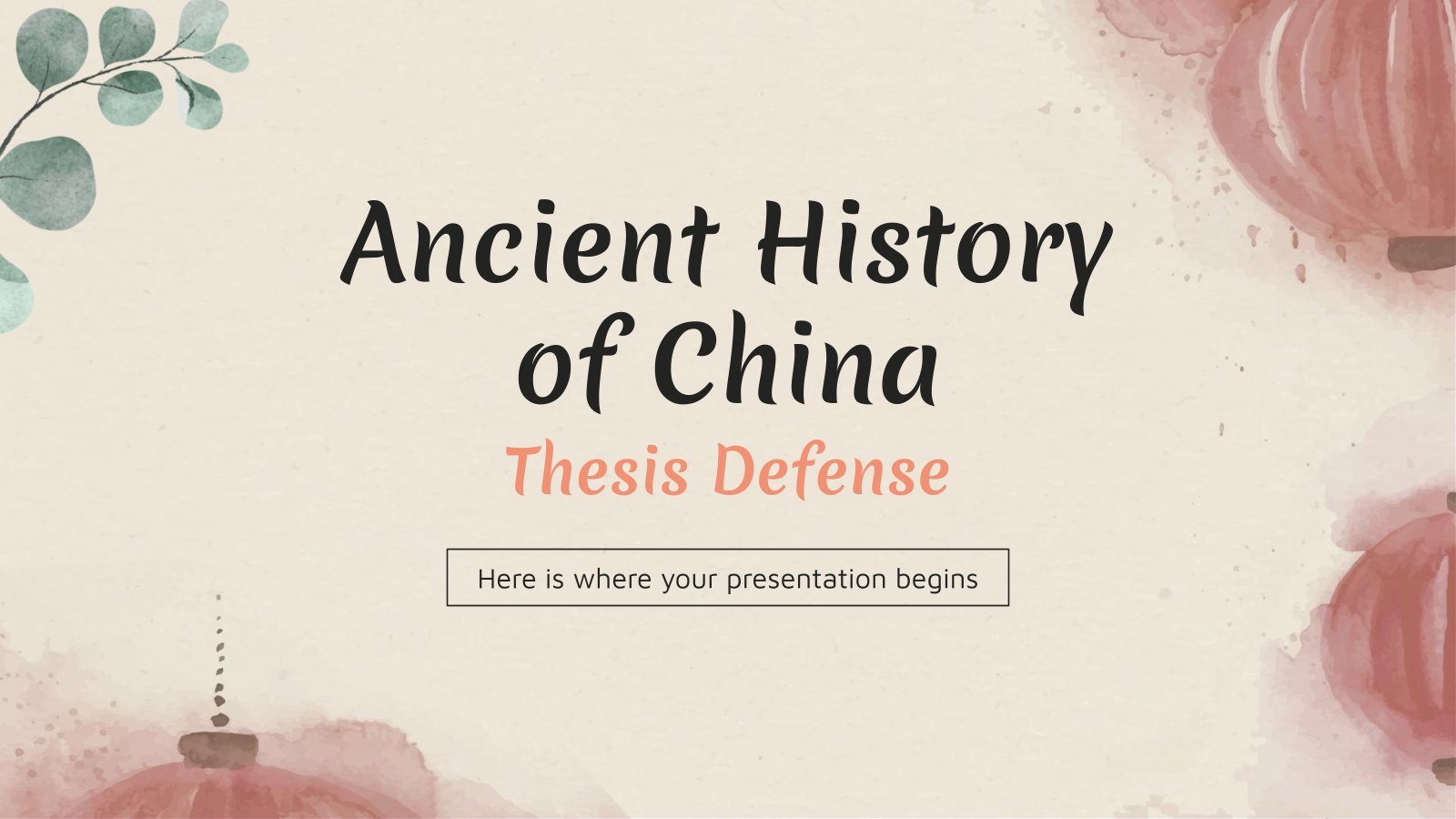
Ancient History of China Thesis
China is one of the oldest and greatest civilizations in the history of mankind. This has left a very important cultural legacy and its reflection endures and will continue to endure among us. One of the most important periods of this country was the ancient era, being a very remarkable...

Language Arts Subject for Middle School: Latin Verbs
Download the Language Arts Subject for Middle School: Latin Verbs presentation for PowerPoint or Google Slides. If you’re looking for a way to motivate and engage students who are undergoing significant physical, social, and emotional development, then you can’t go wrong with an educational template designed for Middle School by...

Writing History Thesis
Are you finishing your writing history thesis and need a good presentation to impress the examination board? We propose you this vintage style template that fits wonderfully with the topic. It has a simple design, beige background and doodle illustrations of books, papyrus, quills, etc. that add sophistication to your...

Reconstruction Era and the Gilded Age - History - 11th Grade
In the United States, the Reconstruction Era followed the Civil War and sought to unite the nation and grant civil rights. The Gilded Age brought industrial growth, but also inequality and corruption. Both eras shared the struggle for civil rights and equity. So these are two periods loaded with historical...

Generation of '27
Generation of '27 is a group of avant-garde poets and artists who began to publish their work in the 20s of the 20th century. To help you explain this interesting part of Spanish literature to your students, we propose you this old-style brown template, with different illustrations of books, pens,...
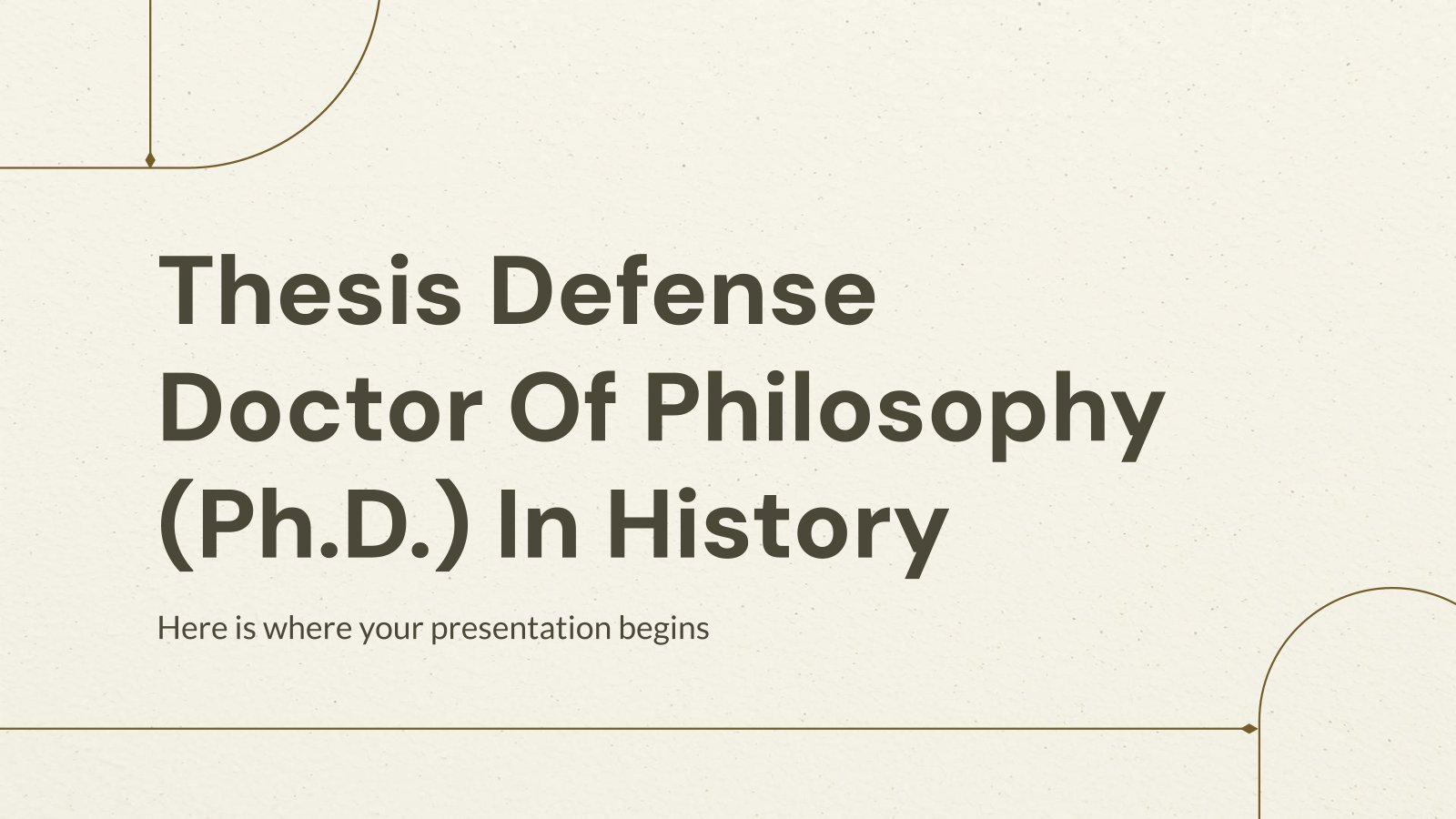
Dissertation Defense - Doctor of Philosophy (Ph.D.) in History
Download the Dissertation Defense - Doctor of Philosophy (Ph.D.) in History presentation for PowerPoint or Google Slides. As university curricula increasingly incorporate digital tools and platforms, this template has been designed to integrate with presentation software, online learning management systems, or referencing software, enhancing the overall efficiency and effectiveness of...

Social Studies Subject for Middle School - 8th Grade: Geography and Colonialism
How did we all humans get to know each other? Well, it’s a complicated story about colonialism, discoveries and adventures, but it can be easy to understand if you as a teacher use the correct resources. This template includes maps, timelines, charts and tables that will give your history lesson...
- Page 1 of 60
New! Make quick presentations with AI
Slidesgo AI presentation maker puts the power of design and creativity in your hands, so you can effortlessly craft stunning slideshows in minutes.

Register for free and start editing online

IMAGES
VIDEO
COMMENTS
Contents. On April 20, 1987, the first version of PowerPoint was released. Because we love the software so much (and we know many of you readers do, too!), we wanted to celebrate PowerPoint's 33rd birthday with a whole article dedicated to its origins, history, and use cases! 95% of presentations are created with PowerPoint, 30 Million ...
Archived from the original on October 8, 2015. Retrieved August 25, 2017. Microsoft PowerPoint, virtual presentation software developed by Robert Gaskins and Dennis Austin for the American computer software company Forethought, Inc. The program, initially named Presenter, was released for the Apple Macintosh in 1987.
Microsoft PowerPoint, virtual presentation software developed by Robert Gaskins and Dennis Austin for the American computer software company Forethought, Inc. The program, initially named Presenter, was released for the Apple Macintosh in 1987. In July of that year, the Microsoft Corporation, in its first significant software acquisition, purchased the rights to PowerPoint for $14 million.
1997 became the year that changed the course of PowerPoint history forever. PowerPoint 97 was released with major improvements and updates, most notably, custom animation. This allowed presentations to faded-zoom into the future. And the fact that users needed no special programming skills to animate their presentations made everyone pinwheel ...
When PowerPoint was introduced in 1987, presentations changed forever. It wasn't long before the presentation software took over and tools like overhead projectors and slide carousels became storage room trash. Before slides were designed on computers, they were made by hand. It took several days to design a slide deck and it was really ...
Here, the principal developers of PowerPoint—Dennis Austin and Tom Rudkin—describe the structure of the source code defining slides. Austin and Rudkin worked closely with the product's architect, Bob Gaskins. This document is in a collection of materials donated to the Computer History Museum by Dennis Austin.
A small Silicon Valley startup called Forethought developed PowerPoint 1.0 in 1987. Throughout its three-year development period it was called Presenter, but the name had been taken. One of the key figures at Forethought, Robert Gaskins, thought of "PowerPoint" from a sign he had seen on an airport runway: he imagined the software ...
So here's the history of PowerPoint, from 1987 to present day. But first let's jump ahead a bit…. It's 2003. The then U.S. Secretary of State, Colin Powell, walks onto the stage to deliver a speech to the United Nations Security Council. Using PowerPoint as a tool of persuasion, he presents a compelling argument in support of the Bush ...
3.3. PowerPoint 3.0. In the history of PowerPoint, there was hardly any bigger update than the transition from 2.0 to 3.0. Most of the features we use today were created for MS PowerPoint 3.0 - including audio, video, and of course - the ability to add presentation templates. This version was the one to come up with slide transitions. 3.4.
Microsoft PowerPoint happened. Its revolutionary and innovative approach to creating presentations gave it an edge over its more than thirty competitors. Its timing with the booms of both the Apple and Windows operating systems—primitive as they were—cemented its growth. And its fundamental function hosted other uses it wasn't intended ...
In the present PowerPoint continues as the standard of presentations everywhere, but that position is never secure. New competition appears regularly. 1984. In September 1984 I found myself out of work for the first time in my career. Gavilan Computers laid me off.
PowerPoint also enabled users to embed a presentation into a webpage or a blog, or run it as a slideshow, or simply record it as a video. The latest version of PowerPoint is capable of churning out stunning animations, audio-visuals, infographics coupled with video insertion as well.
PowerPoint was developed by a former Berkeley Ph.D. student known as Robert Gaskins. His idea was to develop an easy-to-use presentation program based on a series of slides. As is the case with most successful ventures, PowerPoint had the most humble beginning from a place one wouldn't have fancied as the best place to make the most ...
A Brief History of PowerPoint. According to Microsoft estimates there are more than 500 millions users of PowerPoint worldwide, of which 120 million people are using it to create business presentations and 6 million teachers around the world use it in the classroom. A 2012 study suggested that PowerPoint had 95% of the presentation software market.
The History of Presentations. Before we look back on some of the earliest slide presentations, it's important to understand just how far back presentations go. ... LinkedIn's 2004 pitch deck presentation represents the drastic changes that slides experienced from the earliest presentations to the post-PowerPoint era. You can see that the ...
There are two ways to check version history here, and we'll show you both. First, click "File" in the menu bar. In the left pane, click "Info." Click "Version History" on the right. Alternately, you can click the file name at the top of the document that you've opened and select "Version History" from the pop-up menu.
Download the Winston Churchill History Lesson for High School presentation for PowerPoint or Google Slides. High school students are approaching adulthood, and therefore, this template's design reflects the mature nature of their education. Customize the well-defined sections, integrate multimedia and interactive elements and allow space for ...
Free Famous Event in History Presentation. This is a dark blue history PPT template free download with white fonts and graphics. This template works well for historical reports or school projects. 3. Free Women's History Month Presentation. This PowerPoint history template is free to download.
When presentation slides were first created, actually, they would have been considered a work of art. Before PowerPoint and similar software was available, slides were hand-crafted. Paula Tesch provides the majority of the information for these type of slides, so please check her article out. Artists were specifically hired to design slides as ...
19th and 20th Century European History. These PowerPoints are available free of charge for teachers to use in their classrooms. Click to download! World History PowerPoints. Click a thumbnail to download! American Government PowerPoints. Click a thumbnail to download! Thanks for Visiting TomRichey.Net!
Download your presentation as a PowerPoint template or use it online as a Google Slides theme. 100% free, no registration or download limits. Use these history templates to create engaging presentations that bring historical events to life. No Download Limits Free for Any Use No Signups.
Powerpoint presentations on History free to download History is the study of past events, particularly human activities, societies, and civilizations. It encompasses the exploration, analysis, interpretation, and understanding of the past based on various sources of evidence, such as written records, archaeological findings, oral traditions ...
A strong presentation is so much more than information pasted onto a series of slides with fancy backgrounds. Whether you're pitching an idea, reporting market research, or sharing something ...
Learn how to use PowerPoint better, from setting up your slide designs to working with text, images, video, charts, multi-media, and more. Discover how to work with PowerPoint's core presentation tools to make great presentations quickly, while maximizing your presentation design workflow. If you only have a few minutes to spare, then be sure ...
Elevate your industrial engineering thesis defense with our sleek, minimal template designed specifically for engineering professionals. This grey-toned PowerPoint and PPT template, also fully compatible with Google Slides, sets the perfect backdrop to showcase your research and findings in a clear, concise manner. Ideal for presenting complex ...
Download the Seminar in Comparative History - Master of Arts in History presentation for PowerPoint or Google Slides. As university curricula increasingly incorporate digital tools and platforms, this template has been designed to integrate with presentation software, online learning management systems, or referencing software, enhancing the ...